Eber’s water towers – Germany
The leading trade journal in Sweden, VA-tidskriften Cirkulation has since 1998 an article series under the heading Ebers vattentorn (Eber’s water towers), where Eber Ohlsson with text and photo presents interesting water towers in the world (except Scania and Sweden). Below is a free translation to English of these texts.
Eber’s water towers in Cirkulation 2/2024
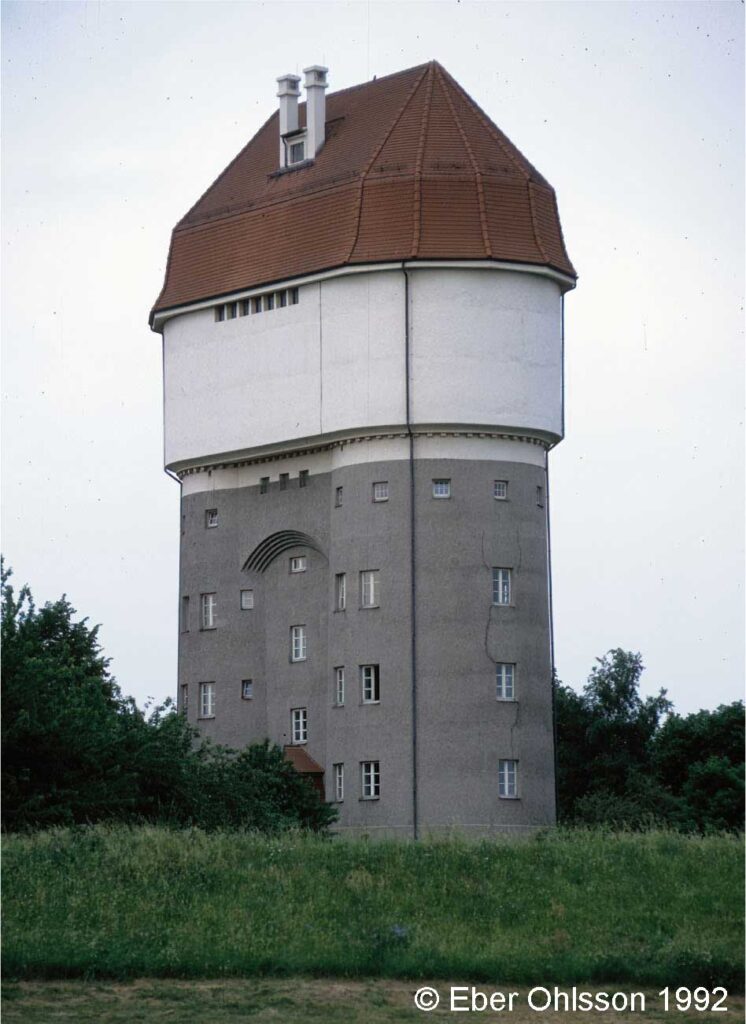
A free translation to English:
80 steam locomotives in the activity on a shunting yard with 73 tracks in width require a lot of water. Therefore, in 1915-16 built a water tower with housing was built in Hohenbudberg, west of the Rhine in the German Ruhr area. River water was purified and pumped into the 35 m high tower, with two reservoirs on totally 1 000 m3.
Since the shunting yard was Germany’s second largest and militarily very significant, it became heavily damaged during World War II, but rebuilt. The tower lost its importance with electrifying of the railway, and is now a listed building. The structural transformation of the society entailed closing-down of the shunting yard 1986.
Published 2024-03-20
Eber’s water towers in Cirkulation 6/2023

A free translation to English:
When building new adjacent to older buildings, the architecture of the new building is usually adapted to the old one. The water tower in the city of Rastatt in southwestern Germany, close to the Rhine River, with its architecture is adapted to the city, the Baroque castle and the adjacent Pagodenburg mini-castle.
The water tower from 1901, which is 47 meters high and has an Intze reservoir of 670 m3, was designed by architect Professor Friedrich Ratzel. He put a great deal of energy into designing the roof, which came to be one-third the height of the building. The tower got at the bottom of an extension from 1953, cafe and restaurant business.
Published 2023-10-11
Eber’s water towers in Cirkulation 1/2023

A free translation to English:
In Gütersloh, a city in German North Rhine-Westphalia, the Prussian state railways built a 30 m high water tower in 1917 in reinforced concrete with a reservoir of 285 m3 to supply the steam locomotive with water. Next to the tower was the household appliance manufacturer Miele’s factory.
When the steam locomotives and the need for water disappeared for the railways in the 1950s and Miele’s factory simultaneously grew and enclosed the water tower, Miele leased the tower and water rights in 1959. They bought it in 2013, restored it for EUR 250,000 and repainted the tower in its colors, red and white. The water tower is now marked as a cultural monument.
Published 2023-02-08
Eber’s water towers in Cirkulation 3/2022

A free translation to English:
Building a water tower on top of an old gunpowder magazine may seem like a proposal with explosive force. However, this was carried out in the Bavarian town of Neu-Ulm, next to the more famous Württembergian town of Ulm across the Danube river.
The water tower was built in 1898/1900 in baroque style on an old fortification market and received a total height of 48 meters, of which the existing gunpowder was 6.6 meters. The height of the water mirror above the ground in the Intze construction was 33.5 meters and the reservoir received a volume of 350 m3. Of course, there is no gunpowder in the building, as is well known that the gunpowder shall be kept dry.
Published 2022-11-09
Eber’s water towers in Cirkulation 3/2022

A free translation to English:
Rödelheim is today a district of German Frankfurt am Main, but was in 1899 when the water tower was built its own city. Civil engineer Max Hessemer designed and built the tower on his own account, but where the ground was made available to the city. Basalt bricks from a nearby quarry cover the 10 m high foot and slate covers the twelve-sided reservoir section.
The tower has a height of 51 meters and has two reservoirs totaling 380 m3. When Rödelheim was incorporated with Frankfurt in 1910 and connected to its pipe network, the tower was taken out of service. It has been on the list of protected buildings since 1972.
Published 2022-04-27
Eber’s water towers in Cirkulation 7/2021
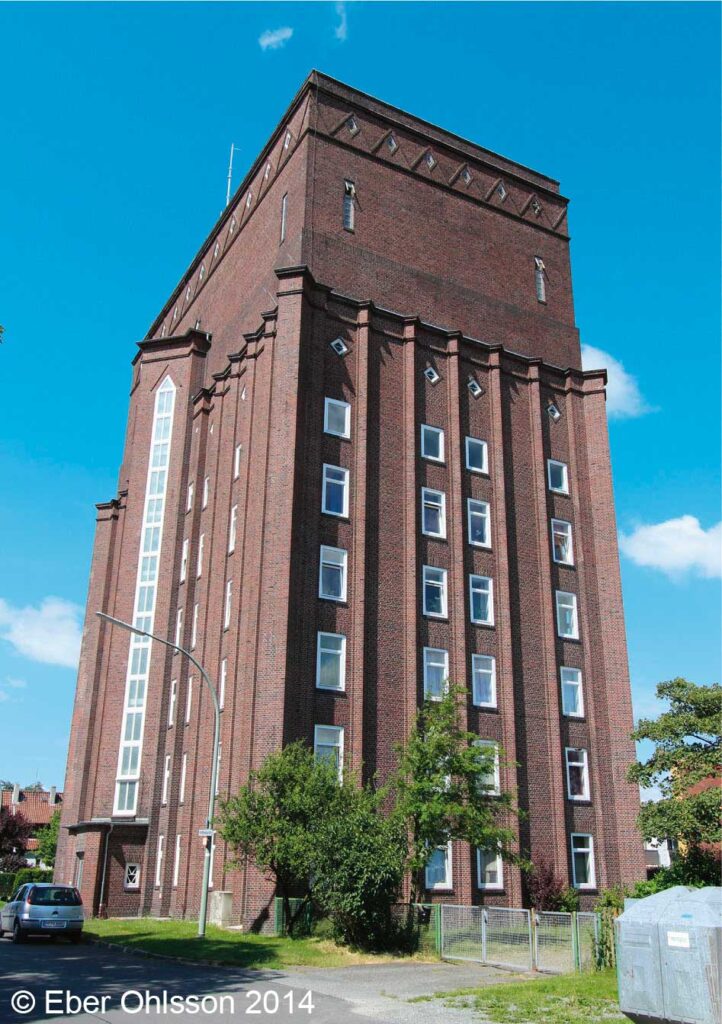
A free translation to English:
Brick expressionism is an architectural style that was common in the 1920s and 1930s in northern Germany and 1926-27 a water tower of this style was built in Wulsdorf in Bremerhaven. A water tower that also has housing, something the Germans call Wohnwasserturm.
The 34 meter high tower consists of a reinforced concrete skeleton, filled with brick walls. At the top there are two concrete cisterns totaling 1,500 m3, and there under 24 housing units. The building has pilasters and marked corner pilasters and triangular stairwells protruding from the façade. The water tower is a building memory since 1978 and was taken out of service in 1996.
Published 2021-10-20
Eber’s water towers in Cirkulation 4/2021
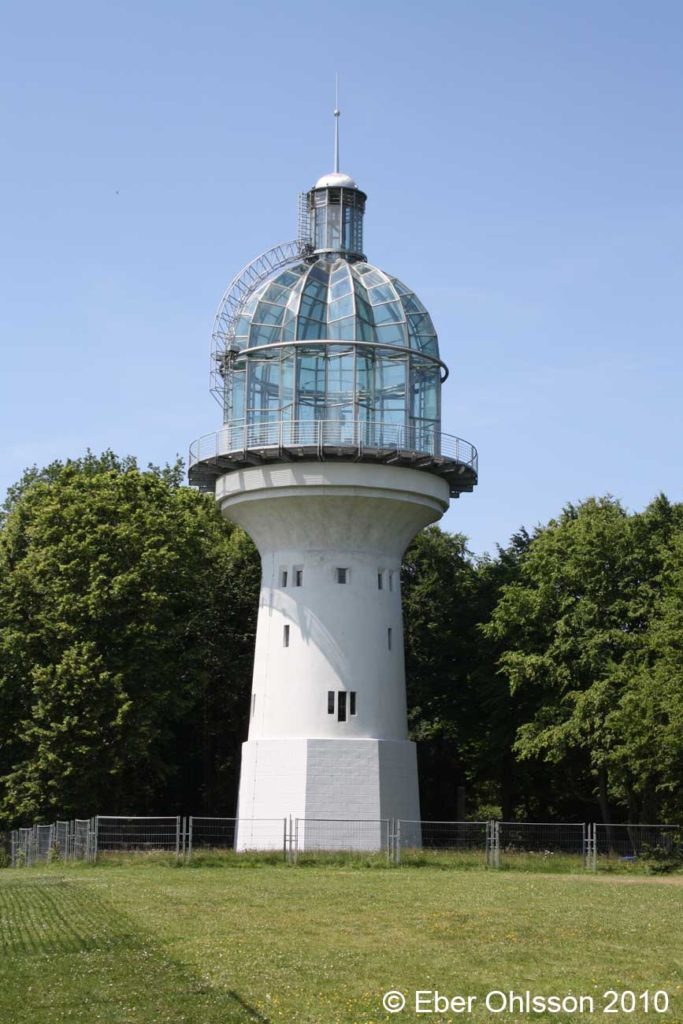
A free translation to English:
The water tower in Gräfrath,in the famous knife manufacturing town of Solingen in the German Ruhr, shows how to transform an old water tower to a tower with high-tech edge. It was built in 1904 as a classic Intze-water and was then in operation until 1983. Instead of demolition became the tower a historic building, but unused for 10 years.
Now, the tower has become a showcase for two light technology firms, but also a tower where regenerative energy is shown, and since 2009 geothermal energy. Under the glass dome are also cultural events organized on a little higher level. A sharpened towers, Lichtturm Solingen.
Published 2021-06-09
Eber’s water towers in Cirkulation 7/2020
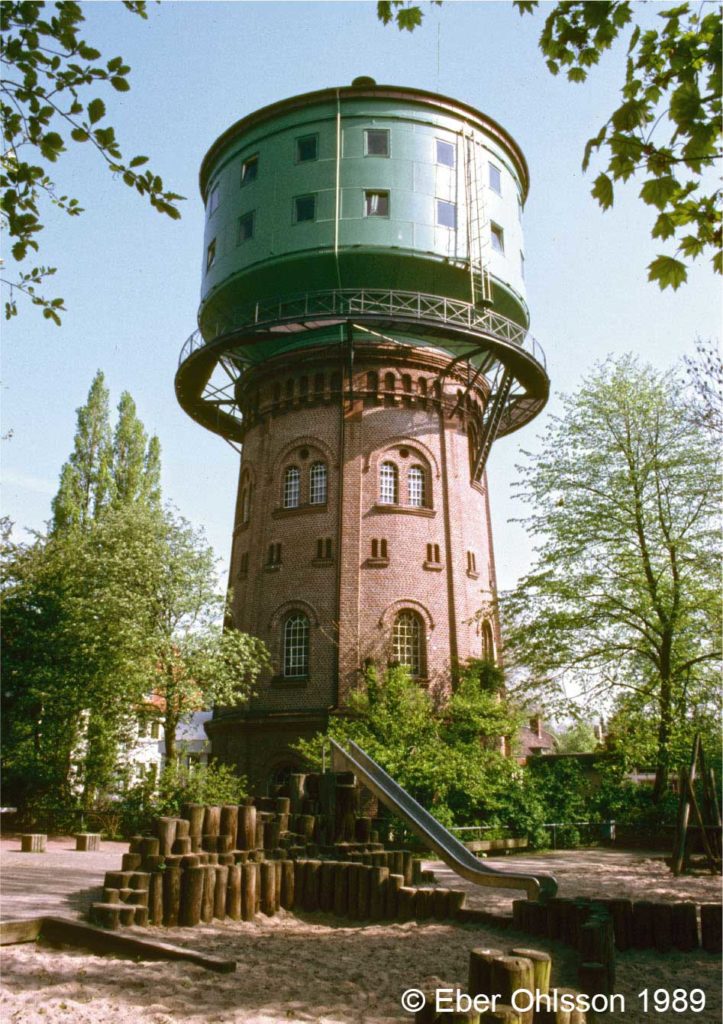
A free translation to English:
At the highest point in the town of Steele in the German Ruhr area, a water tower with a brick tower shaft and a 1,000 m3 riveted steel reservoir were built in 1898. Perhaps the steel came from Krupp-Werke, one of the financiers of the 1864 waterworks in Steele. Krupp was based in Essen, a town of Steele was merged with 1929.
Curious is that both Steeles and Krupp’s weapons were three intertwined rings, despite different histories. The tower was taken out of operation in 1986 and became a building memory in 1987. After the sale, the tower was thoroughly renovated and received 32 new windows. Here it first became a gallery until 2006 and then office for an IT company.
Published 2020-11-04
Eber’s water towers in Cirkulation 3/2020
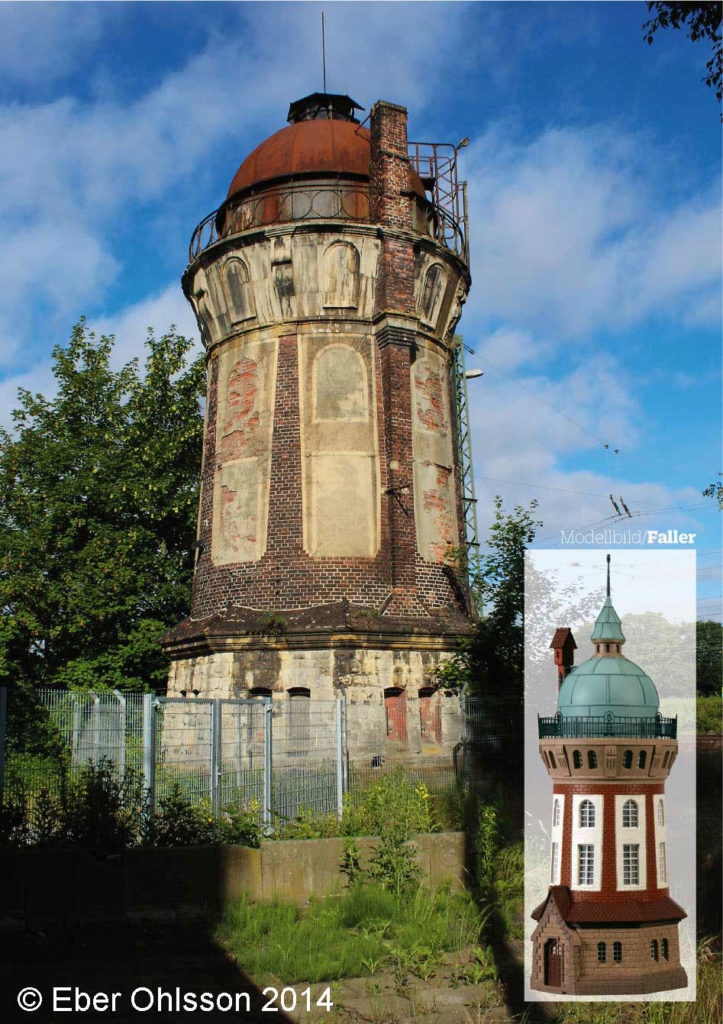
A free translation to English:
The railway water tower in the Westphalian city of Bielefeld in Germany is an iconic building for those with model trains as a hobby. The explanation is that a large manufacturer of buildings and other accessories for model railways have decided to make a model of this particular water tower.
The large tower was originally a detail-rich water tower from 1906, with brick facade and lots of windows under the spherical reservoir, a reservoir form common in the German railways. Now, the windows are bricked up and the former glory has faded. So anyone who wants to see how the tower once looked must study the model.
Published 2020-04-15
Eber’s water towers in Cirkulation 7/2019

A free translation to English:
A brick expressionist water tower with antique architectural elements stands in the German capital’s district of Steglitz. With the start of construction in 1916 of the then independent Steglitz followed many difficulties, where the First World War and its economic consequences, not least lack of pipes done that the tower first 1928 could be in operation with its 2 000 m³.
The tower became damaged during World War II, but was able after a repair in 1950 to be in operation until 1962. It became a listed building in 1992, and after a renovation in 2000, is it now in the tower, which stands at Steglitz cemetery, office for a medical publishing company.
Published 2019-11-06
Eber’s water towers in Cirkulation 4/2019
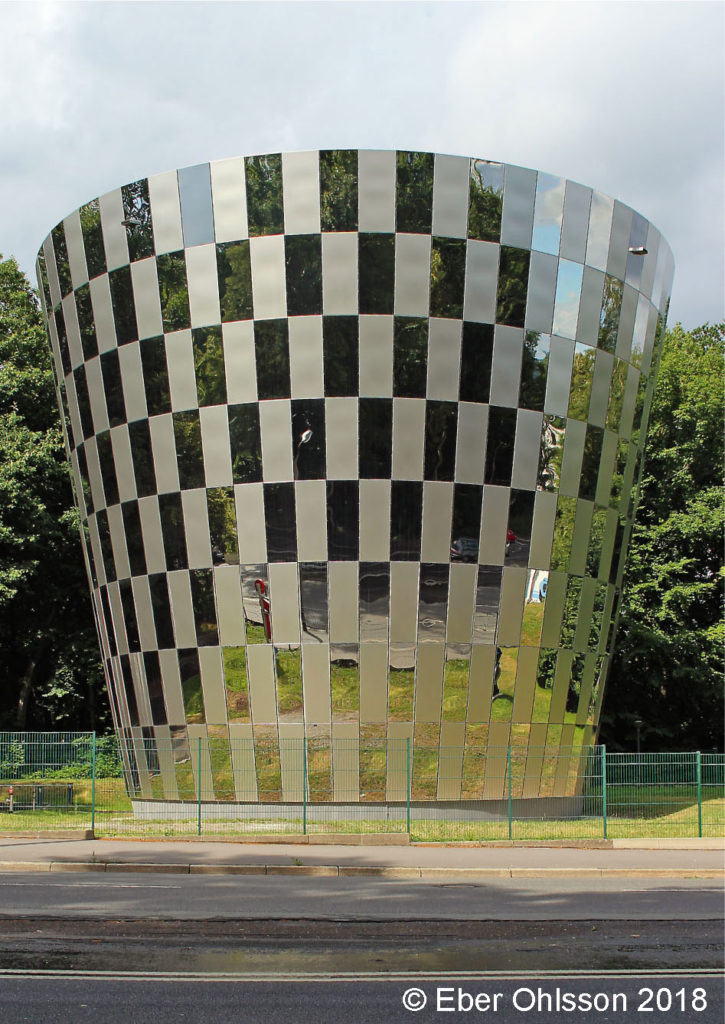
A free translation to English:
To be mirrored itself in a water tower is not possible on so many towers, but something that is possible on the new water tower in the German city of Chemnitz in Saxony. On the 1 350 m² large facade, the artist Peter Apfel has with 400 pieces of 2.5 meter high stainless steel plates in two silver gray shades, matt and reflective, made this possible.
The Chemnitz tower has first been built as a 22 meter high cone in reinforced concrete and has subsequently been covered with stainless steel plates to get a varied facade. The total construction cost was EUR 4.6 million, including government grants, where the extra facade cost EUR 400,000.
Published 2019-06-04
Eber’s water towers in Cirkulation 6/2018

A free translation to English:
1918, 100 years ago, a brick-expressionist water tower was standing clear in Eberswalde, a city north of Berlin. The 49m high tower with four pillars and a 200 m³ reinforced concrete reservoir was designed by architect Paul Mebes. The builder was the great brass foundry here, with ancestry back to 1698.
The brass foundry was a war-trophy in 1945, but re-industrialized in the early 1950s. The water tower was out of operation in 1964 and renovated for a lot of money 2004-2011. Today there is information here about the water tower and the brass foundry. You can see the whole tower as well as take the elevator up to the viewing platform.
Published 2018-09-19
Eber’s water towers in Cirkulation 3/2018
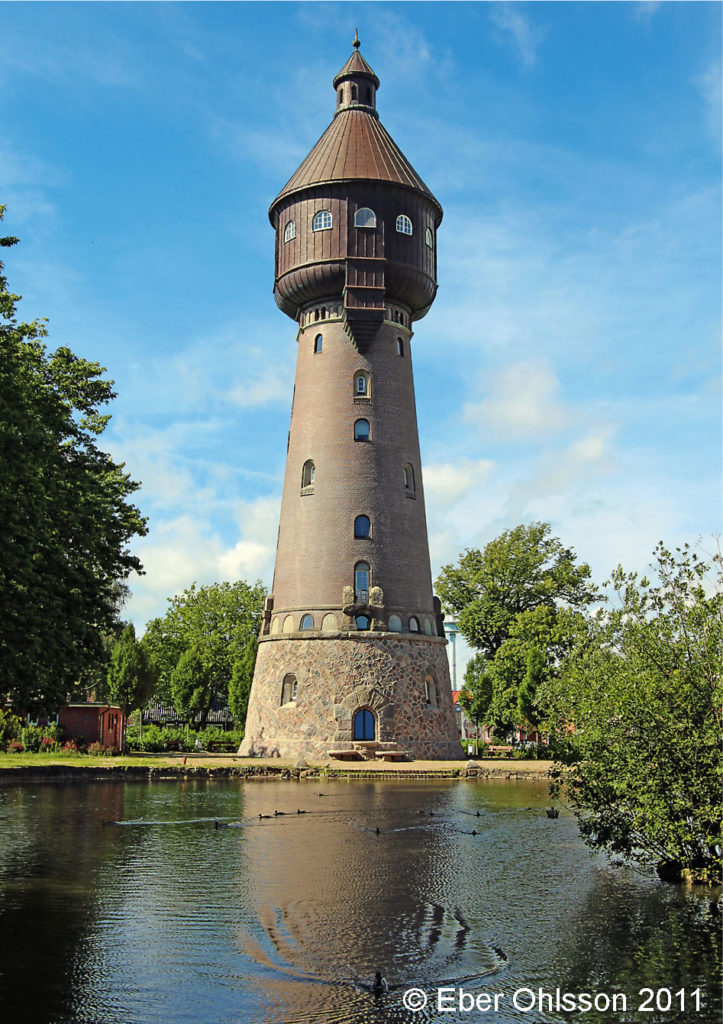
A free translation to English:
The town of Heide in German Holstein has since 2005 marketed its water tower as an appropriate place for marriages. For this event you must take a lift to level 8, and then go in a spiral staircase up to level 10. Here in the wedding room, where once the water tank stood and now has room for 24 people, there are views in all directions.
When the 46 m high water tower was built in 1903, it got a reservoir with a volume of 225 m³. Tower architect was Wilhelm Voigt. The beautiful water tower became a monument heritage in 1978 and was out of operation 1989. Heide is otherwise known to be the capital of the medieval peasant-republic Ditmarsken.
Published 2018-04-25
Eber’s water towers in Cirkulation 6/2017

A free translation to English:
The Irish veterinarian and inventor John Boyd Dunlop was the one who got the patent for the pneumatic ring. His first overseas factory was built in Hanau, a town just east of Frankfurt am Main in Germany. The current plant was built in 1903 and the water tower ten years later.
World War II bombing raids brought havoc to the German cities and industries, and in 1945 became the whole Dunlop factory in Hanau completely destroyed at such a raid – everything except the water tower. The factory is now rebuilt and in the center of the factory area boasts the water tower with the company name and logo on the reservoir facade.
Published 2017-10-04
Eber’s water towers in Cirkulation 3/2017
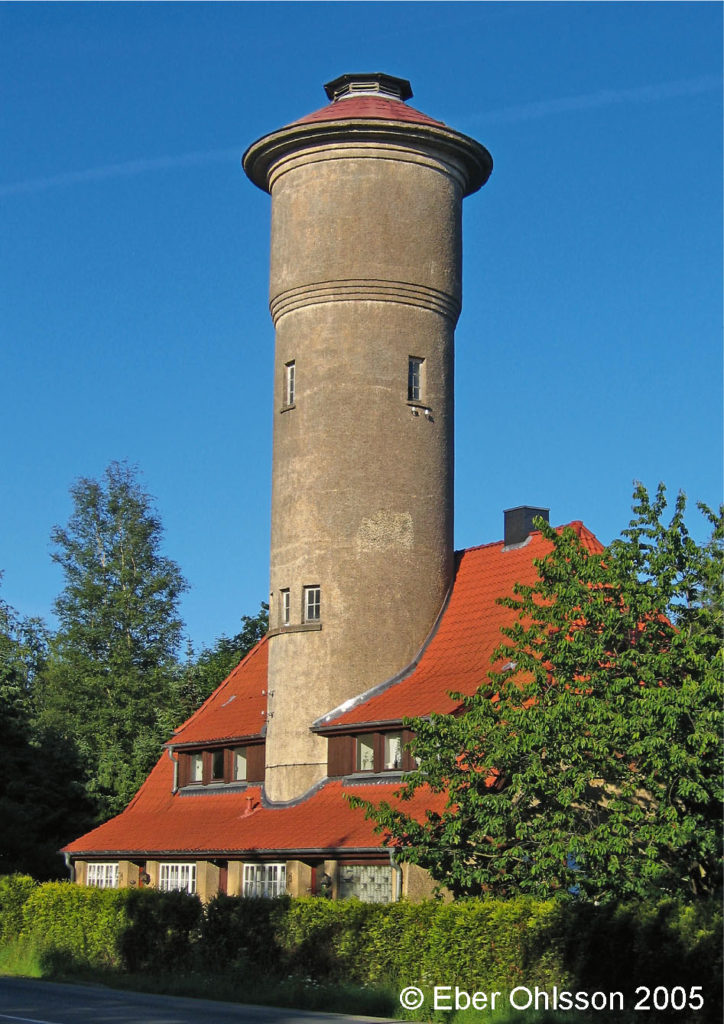
A free translation to English:
Hartmann Freiherr von Richthofen bought in 1920 the castle Gotthard in Rotenburg/Wümme in the German Lower Saxony. Immediately, he began rebuilding and expansion of the estate, where he at the main road southwards towards Verden built a water tower house for the estate’s water supply.
On the top of the tower was there originally a windmill that could give power to the water-pumping. Now is the windmill gone as well as the 1972 demolished castle, while the house with the large water tower is still standing. If the name von Richthofen sounds familiar, is it probably because of the cousin Manfred von Richthofen, better known as the flying ace Red Baron.
Published 2017-04-19
Eber’s water towers in Cirkulation 7/2016
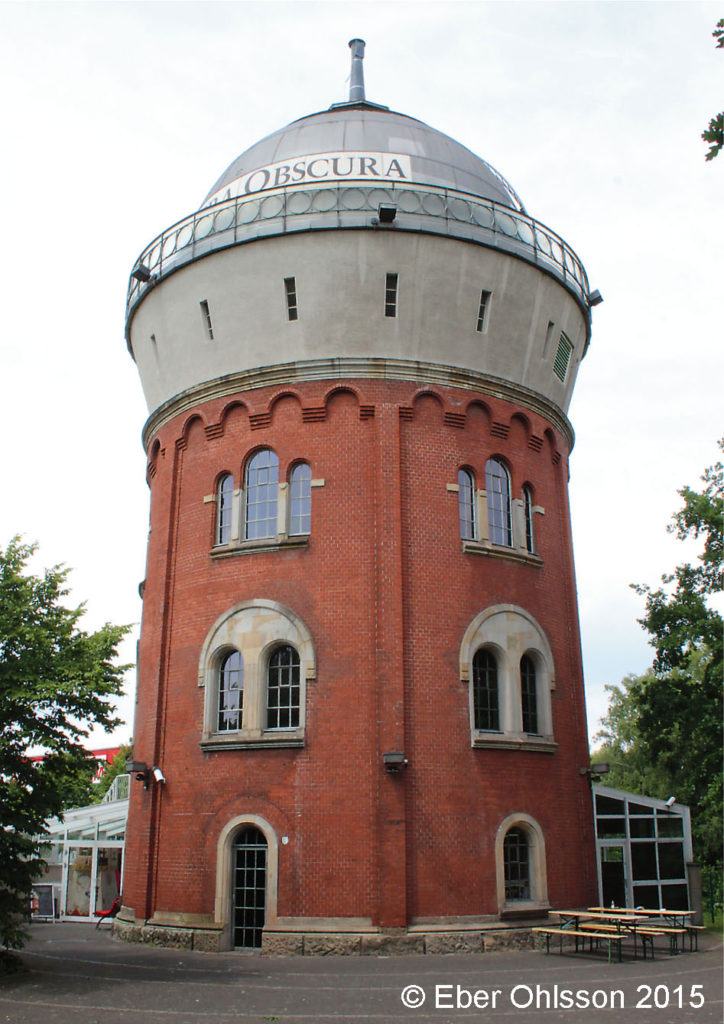
A free translation to English:
The world’s largest camera obscura of its kind found in a water tower in the German Mülheim an der Ruhr. The 25.5 meter high water tower was built in 1904 to supply the national railway’s steam engines with water. The area with roundhouses and a large railway workshop was bombed in 1943, but luckily survived the water tower without damage.
When Mülheim 1992 organized a large garden exhibition in the railway area, was installed at the top of as a historic building declared water tower a camera obscura, as here meant that in a dark room through a small light aperture in the ceiling and through the lenses depicted outside world.
Published 2016-11-02
Eber’s water towers in Cirkulation 1/2016
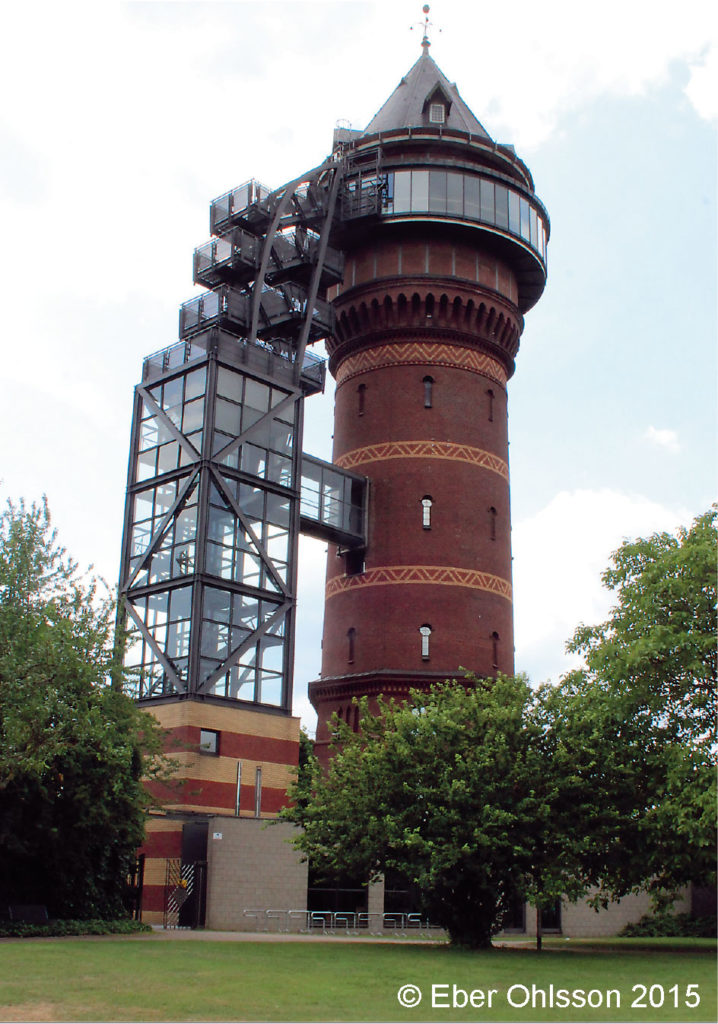
A free translation to English:
From water reservoir to knowledge reservoir is the self-description of Aquarius Wasser Museum in Mülheim an der Ruhr, Germany. The water tower was built in 1892/93 when August Thyssen would arrange water supply for his rolling mills and mines. The 35 meter high water tower had a reservoir of 500 m³.
1912 transferred the water tower to the recently formed RWW Rheinish-Westfälisches Wassergesellschaft. In 1982 the tower was taken out of service and it as a historic building declared water tower become in 1992 a water knowledge center to highlight different aspects of the water. It has inspired Swedish counterparts.
Published 2016-02-10
Eber’s water towers in Cirkulation 7/2015
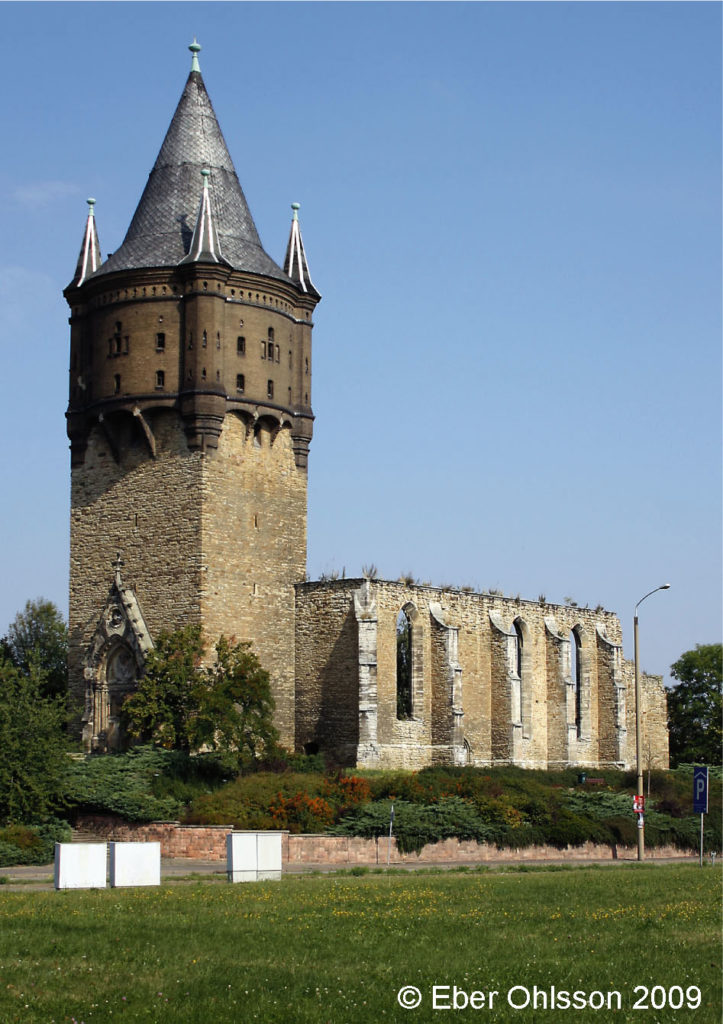
A free translation to English:
In Germany it is not unusual to find war-damaged churches or churches that have become ruins. Hanseatic City of Merseburg, located between the cities of Halle and Leipzig, was hard hit during the Second World War, not least because there is great chemistry industries near the city, there among other things synthetic gasoline was produced.
In the town is also the ruin of the Church of St. Sixti, founded in 1045 and during the 1500s rebuilt to late Gothic, but that was became ruin during the Thirty Years War. The old church tower was rebuilt in 1888 to the city’s new water tower, a function it is now, however, have lost.
Published 2015-11-04
Eber’s water towers in Cirkulation 3/2015
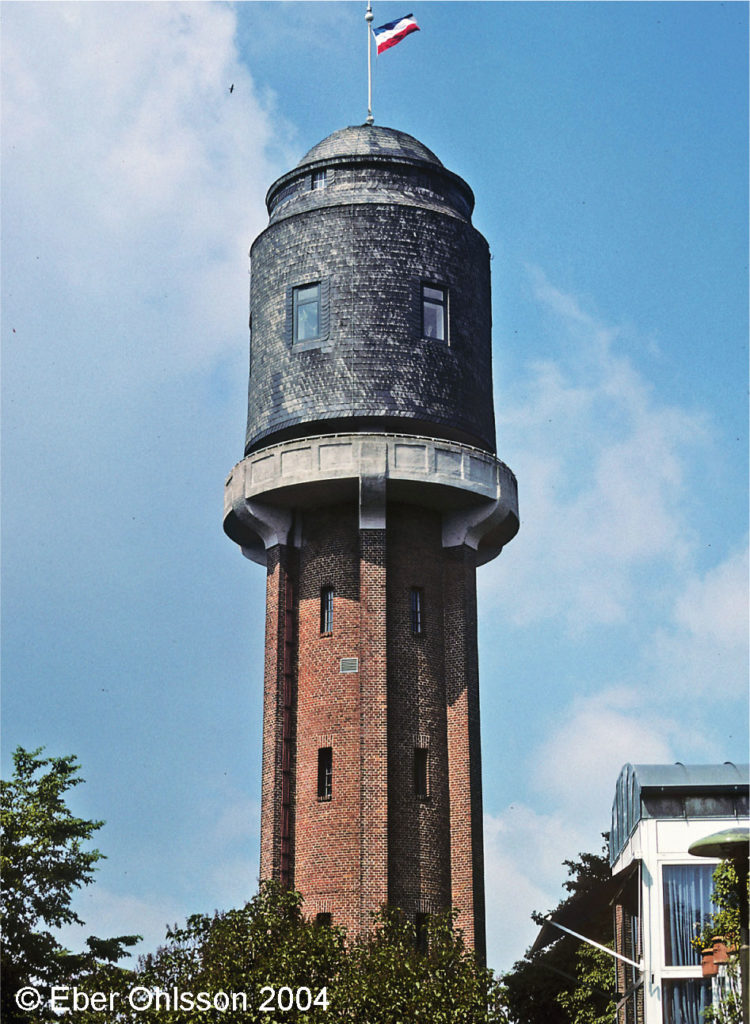
A free translation to English:
Holiday house is often associated with a small house on a lake or the sea. However, there are alternatives, like the water tower in the northern German town of Plön. The town is located in an area called Holstein Switzerland, an area shaped by the last ice age.
The 42 m high water tower was built in 1913 and held the 150 m³ of water before it was decommissioned in 1974. The Water Board wanted to tear it down, but instead it became a historic building. With a new owner was the tower in 1984 converted into a residence. So now one can rent 100 m² apartment and take a bath in a water tower and at a balcony that goes around the entire tower, have views over the Plön’s lake system.
Published 2015-05-06
Eber’s water towers in Cirkulation 7/2014
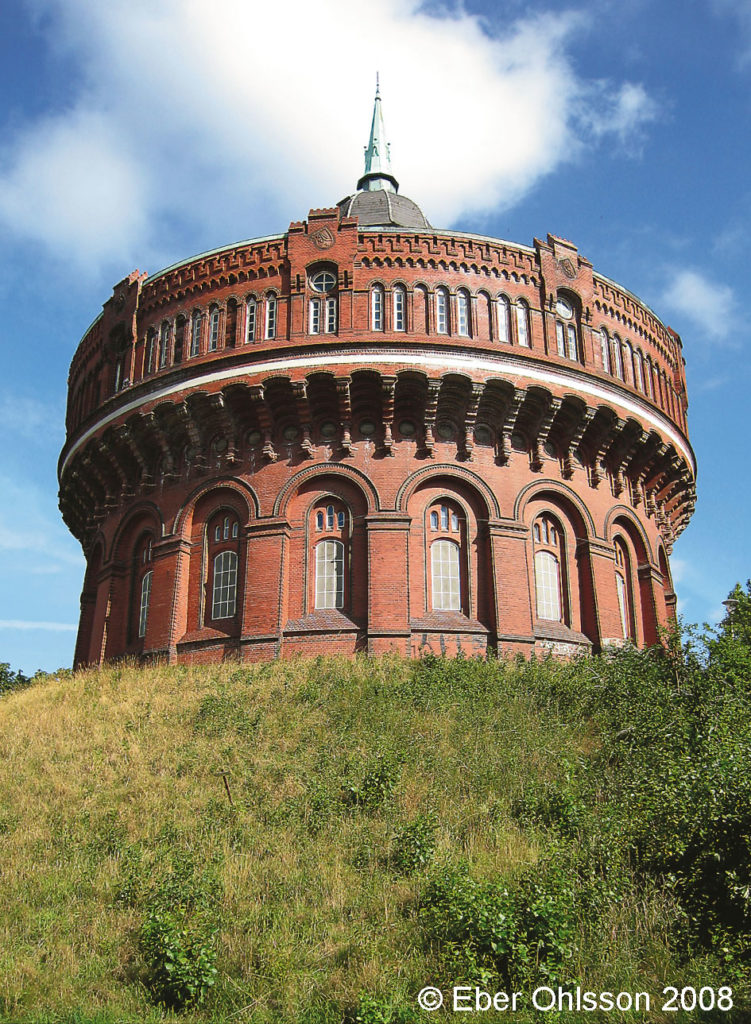
A free translation to English:
In the district Ravensberg in the northern German city of Kiel was built in 1886 an elevated storage reservoir of 2 500 m³ as a large earth reservoir. Then something happened that has happened in other cities, the water pressure was not sufficient when higher grounds in the city was built and the houses in the town became higher, it needed a new water tower.
On the top of the earth reservoir got Kiel 1898 a 34 m high brick water tower, designed by Rudolph Schmidt. The reservoir volume was 1 500 m³ with 15 m higher highest water level than the highest water level of the earth reservoir. The tower became a listed building in 1976 and was decommissioned in 1990, and privatized 10 years later. Now is the tower under reconstruction and get 33 unique apartments.
Published 2014-10-29
Eber’s water towers in Cirkulation 4/2014

In Swedish, the word ”bi” means both ”secondary” and ”bee”.
A free translation to English:
A water tower in the town Visselhövede in Lower Saxony in Germany had during one year a secondary/bee function. The tower, which was completed in 1899, had a height of 25 meters and a reservoir of 20 m³. It belonged to the honey factory ”Sonnentau” and supplied the plant with clean water and good pressure in the production of honey. A function that it only had for one year.
When the factory in year 1900 became connected to the public water supply, became the tower solely fire reserve until 1950. The tower was reconstructed in 2002 and is now an art gallery with a registrar’s office on the balcony floor. Probably for smaller weddings.
Published 2014-06-04
Eber’s water towers in Cirkulation 1/2014
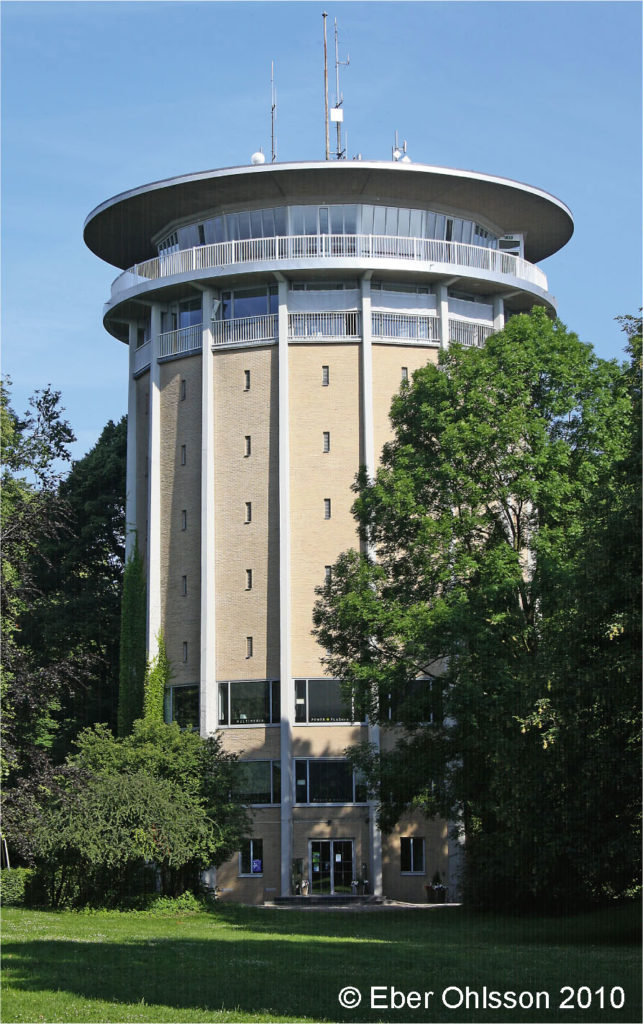
The Swedish word ”rörelse” can mean both ”business” and ”motion”.
The Swedish expression about the business, ”den gick inte runt” mean both ”it did not run so good” and ”it did not turn around”.
A free translation to English:
In Charlemagne’s capital of Aachen, near the triponts for Germany, the Netherlands and Belgium, there is a water tower on the hill Lousberg named Belvedere, the French word for observation tower. The tower, which was built in 1956-58, got offices on the lower plans and in 1970 on the top a revolving restaurant with a viewing platform.
The restaurant closed down in the early 1990’s because the business not run so good. The attempt in 2005 with café ended in 2011, it was not even now spin on the business. The function as a water tower ceased in 1988 and the tower is since 1990 a historical building and an example of the 1950s style.
Published 2014-02-12
Eber’s water towers in Cirkulation 3/2013
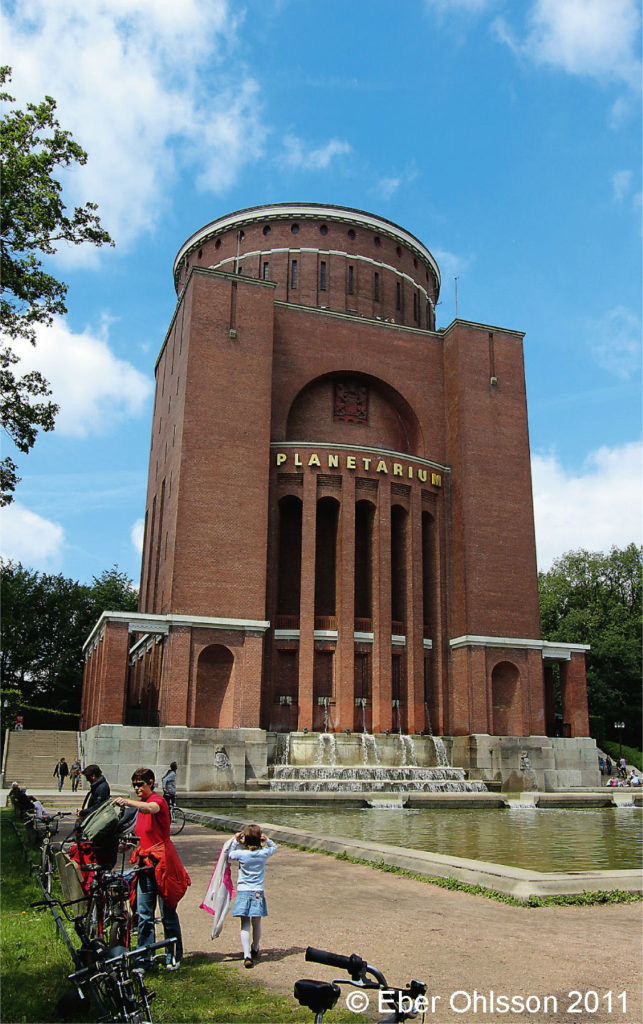
A free translation to English:
Water unites heaven and earth in the eternal cycle. Sky and water were also united in Hamburg’s water tower in Winterhude. Architect Oscar Menzel won the 1907 an ideas competition for this tower, located in the end of a 1 400 m long axis in the Hamburg city park. The tower was in operation in the city high zone 1916 to 1924, when it partially lost its function when the city’s two pressure zones were merged.
1930 a planetarium was added in the tower bottom and 1944 became the water pipe to the tower so damaged by a bomb that the tower was brought out of operation. The 64.5 m high tower, which is heritage building since 1981, contained 3 000 m³ of water.
Published 2013-05-02
Eber’s water towers in Cirkulation 7/2012
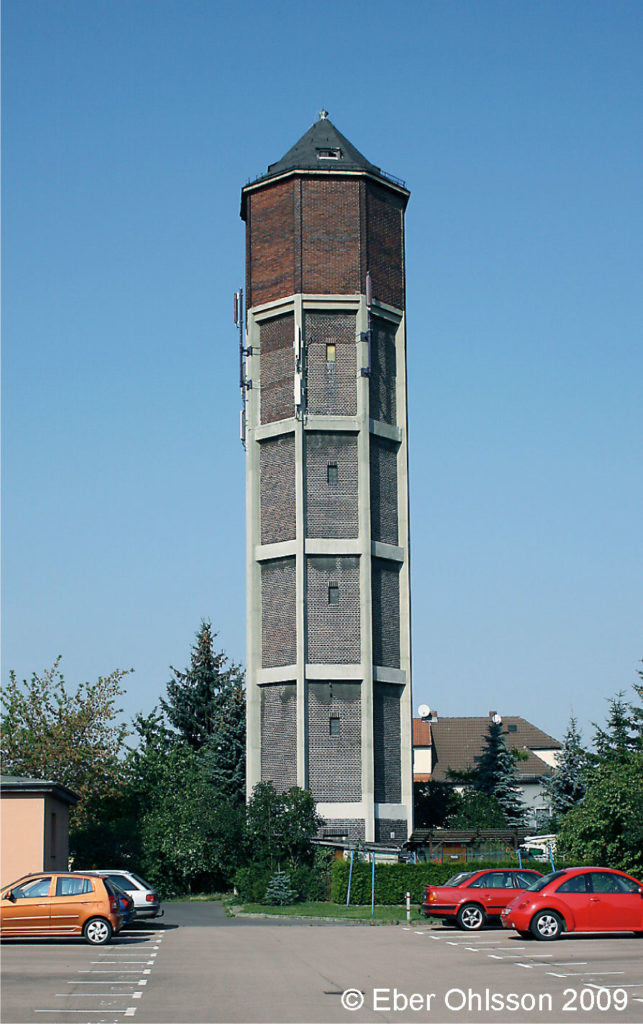
The Swedish king Gustavus Adolphus died on the foggy battlefield Lützen November 6th 1632. November 6th in the Julian calendar, is in today’s Gregorian calendar November 16th. Scania was 1632 not a part of Sweden.
A free translation to English:
Lützen is for many people connected with water-saturated air in November, a conception that especially history books have built up. The air in this German city in the federal state of Saxony-Anhalt and the famous battlefield in the northeast, towards Saxony’s largest city Leipzig, however, is not always water-saturated.
The sun is successful here, as everywhere else, many times evaporate the humidity, which is good when the city’s water tower shall be photographed. By that perhaps this month’s issue of Cirkulation, now 380 years later after the most famous Lützen fog, can be successful to show a different and more sunnier side of the city.
Published 2012-11-07
Eber’s water towers in Cirkulation 3/2012

In the translation is the Swedish word ”enastående” translated to ”remarkable” but can also mean ”stands alone”.
A free translation to English:
A small house on the top of a Eifel tower one might characterize the water tower in the town Groitzsch south of Leipzig in the German federal state of Saxony. It is remarkable, because the other two towers built in the style now is scrapped. Dortmund firm August Klönne designed the 45 meter high water tower, which has a reservoir of 300 m³.
The tower, that was in service 1904, was damaged by bombers in World War II, but was repaired and is still in operation. The public has the opportunity to get onto the observation deck during the City Festival and Doors Open Days, and then it’s obviously a queue.
Published 2012-05-03
Eber’s water towers in Cirkulation 7/2011
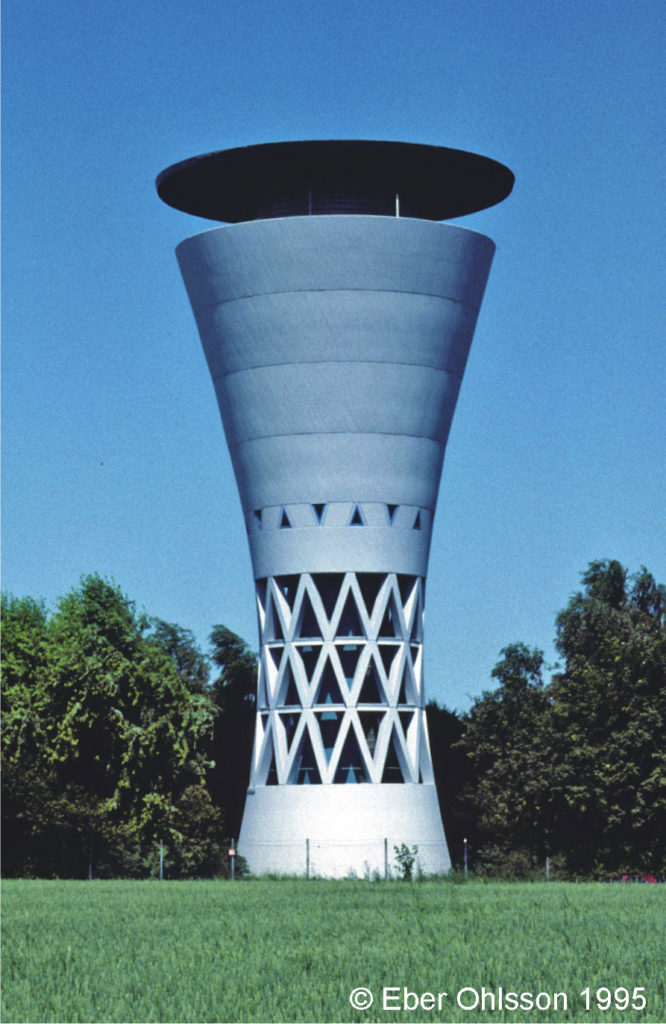
A free translation to English:
The first water tower with a hyperbolic stucture was constructed by the Russian engineer Vladimir Sjuchov to a Pan-Russian exhibition 1896 in Nizhny Novgorod (Gorky during the Soviet era). Hyperbolic towers can be built with straight struts, there the strut angle is narrower in middle than in base and top. It will be both stronger and slender towers.
The 30 meter high water tower in the municipality Möglingen, 15 km north of Stuttgart in the German federal state of Baden-Württemberg, has a reservoir of 400 m³. The tower with a diameter of 9,6 m at the ground, 7 m at the waist and 15,5 m at the top, was designed by architect R Kessler and became operational in 1965.
Published 2011-11-09
Eber’s water towers in Cirkulation 4/2011

A free translation to English:
Borkum is the largest and westernmost of the German East Frisian Islands and consists mostly of marshlands and sand dunes. In earlier times had the islanders there own wells, but with increased population and tourism were there built a waterworks in the sand dunes one kilometer east of the buildings.
Nearer the buildings were there at the same time built a water tower and in 1901 were both in operation. The tower, however, lost its function in 1955, but received in 1983 from the public authority protection as monument and has now got its own conservation association. Northwest of the island is the shoal Borkumriff, known for its lightship and from the radio weather reports.
Published 2011-06-08
Eber’s water towers in Cirkulation 7/2010

A free translation to English:
Water Music was created by George Frideric Handel in the early 1700s. In the former water tower in Misburg near Hanover, Germany, 200 km northwest of Handel’s birthplace, Halle, is water tower music now created, however, it is more rock than Handel’s baroque.
The tower, now a symbol of Misburg, if not beautiful, is an old air protection bunker from the war, which was rebuilt 1959/60 to a water tower. It became privately owned in 1992 and converted into a music bunker with 10 music rehearsel rooms on four floors. Neighbours see it perhaps still as a shelter, now protect against the inside coming rock band sound.
Published 2010-11-10
Eber’s water towers in Cirkulation 4/2010
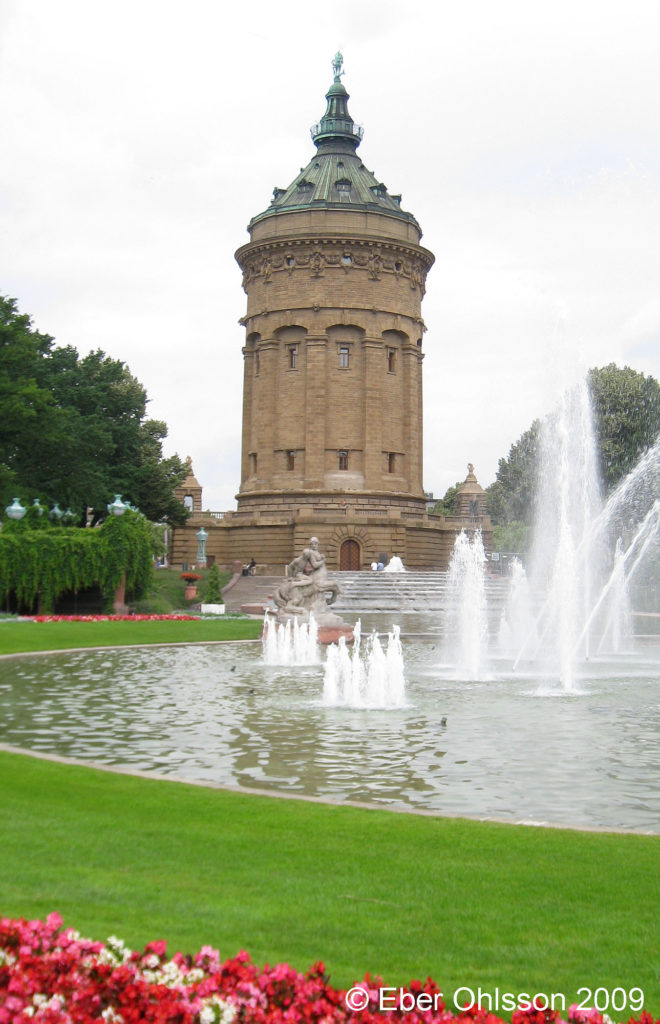
A free translation to English:
The water tower par préférence is standing at Friedrichsplatz in Mannheim, Germany. In an architectural competition of the tower design 1884 won the architect Gustav Halmhuber. With a reservoir of 2 000 m³ was the monumental 60 meter high new baroque tower in yellow sandstone inaugurated 1889, 2½ times more expensive than planned.
Mannheim is a large and very important industrial city on the Rhine, so the tower was roughly treated during the bombing raids 1943-45. After the war, there were plans to rebuild the tower to a concrete construction, but after popular protests the tower was restored in 1960s and is today the city’s pride and symbol.
Published 2010-06-09
Eber’s water towers in Cirkulation 7/2009
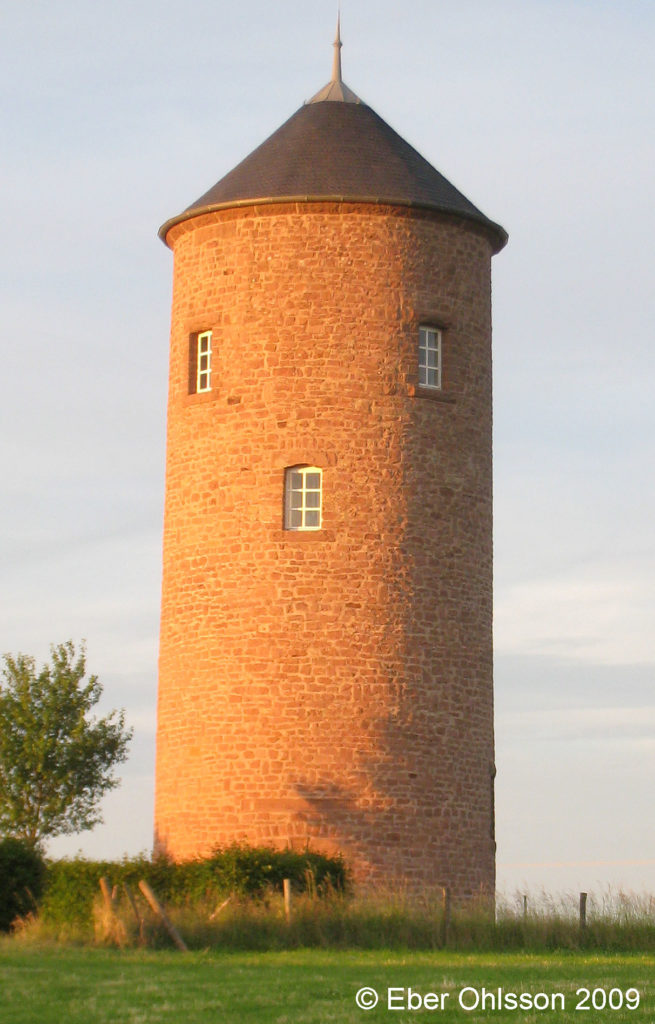
A free translation to English:
6 years of uptime is not much of a water tower. It was between 1957 and 1963 which the 18.5 m high water tower in red sandstone in the village Utscheid-Buscht in the south Eifel Mountains in Germany was in operation. On the other hand, the reservoir volume was not impressive, only 30 m³.
In 1993 transformed the architecture professor Oswald Mathias Unger, the old water tower for their own holiday home in five floors, with a spiral staircase and modern facilities. The present owners, a Dutch couple, has in the tower also created a small concert hall, there the public sometimes is invited to evenings of classical music and poetry.
Published 2009-11-11
Eber’s water towers in Cirkulation 3/2009

A free translation to English:
A water tower gives on distance a distinct signal. In the most cases when you approach a certain place. But the water tower in Hohenlockstedt north of Hamburg in Germany, built 1900-01, and in operation until 1980s, gave in former times a signal that could mean the difference between life and dead.
Here is in a pylon on the tower a raise ball that in former times show when there was live-cartridge practice in the nearby situated training ground of the Prussian army. Here is even a sign on the tower that in German and Finnish state that here have Finnish commandos been trained. Commandos in the battle of Finnish self-government, there later these became the essence of the Finnish army.
Published 2009-05-06
Eber’s water towers in Cirkulation 6/2008
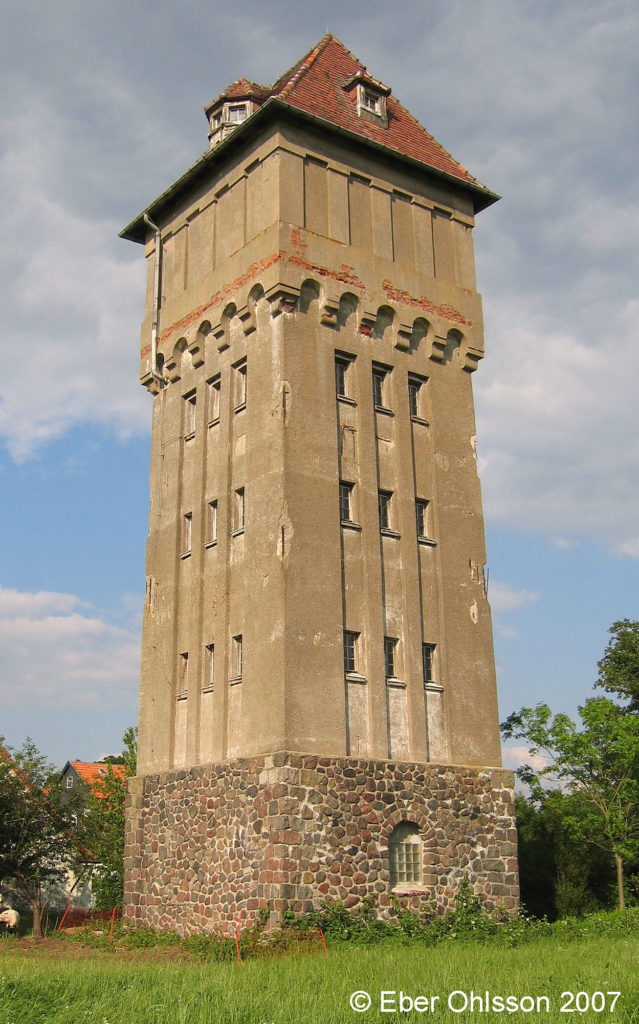
A free translation to English:
It is not quite unusually to find solid water towers on German manors. Such example is the manor Wulmenau, south of Lübeck and only 5 kilometres east of an Autobahn that many from Scandinavia drive when they shall go southbound. These holiday-makers should if they sometimes derivate from the German car artery discover a new civilized world.
The water tower in Wulmenau that was in operation 1912-1972 is built in reinforced concrete on a foundation of natural stone. The five storey high tower with a reservoir on 50 m³ is today classified as a monument. The owner is now looking of investors that can make dwellings in the tower.
Published 2009-09-24
Eber’s water towers in Cirkulation 2/2008

A free translation to English:
There storks exist there is it water. A good rule with considering where these birds got there feed. More unusual is the rule that there storks exist there is it water towers. This is however valid in the German village Rühstädt on the river Elbe, 150 km upstream Hamburg.
In the park of the castle is since 1885 a water tower standing with a stork’s nest since 1952. With further circa 140 storks in the village, the birth rate should be large, but here is only 240 inhabitants living. But they got a stork feather in the hat, when they were elected to the European Village of Storks 1996. The water tower that’s were out of duty 1912 and was been restored 1992 is a symbol of Rühstädt.
Published 2009-03-19
Eber’s water towers in Cirkulation 3/2007
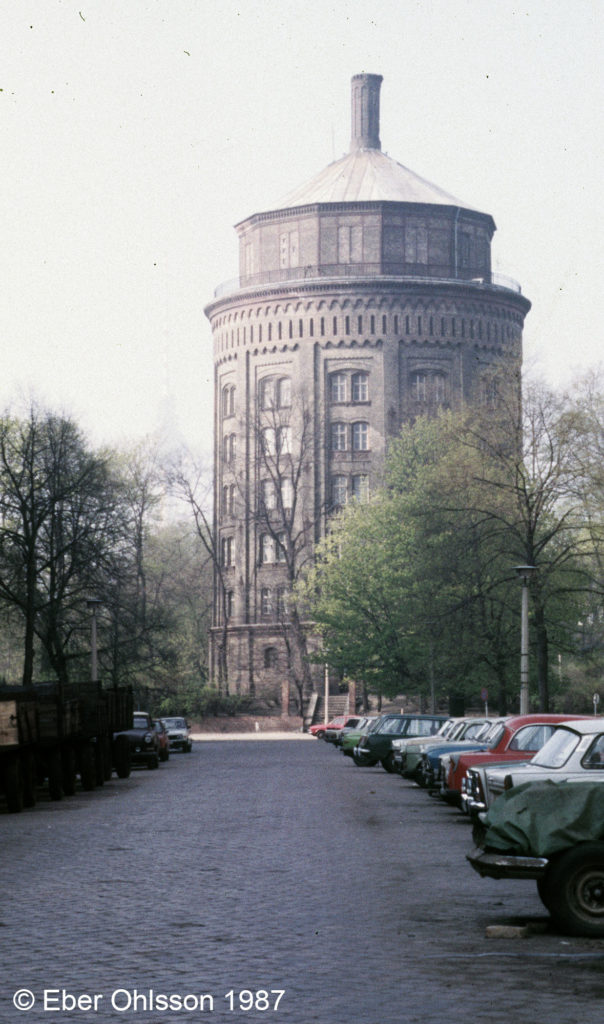
A free translation to English:
A view with water tower, wagons loaded with brown coal and two-stroke cars. The impression of DDR is clear, which not the air was. The smell of brown coal is still perceptible, when the picture of the German water tower on the Prenzlauer Berg in Berlin is projected on the retina. The area around the water tower was from the beginning a wind mill hill, there the English 1855/56 built a water work, which however was closed down 1915.
Still stand, excluding a 150 years old standpipe of bricks, is the water tower on the picture. A water tower with stand pipe built 1875, that was housing flats already from the beginning. It has meet experience from many of Berlin’s political regimes.
Published 2007-04-27
Eber’s water towers in Cirkulation 7/2006
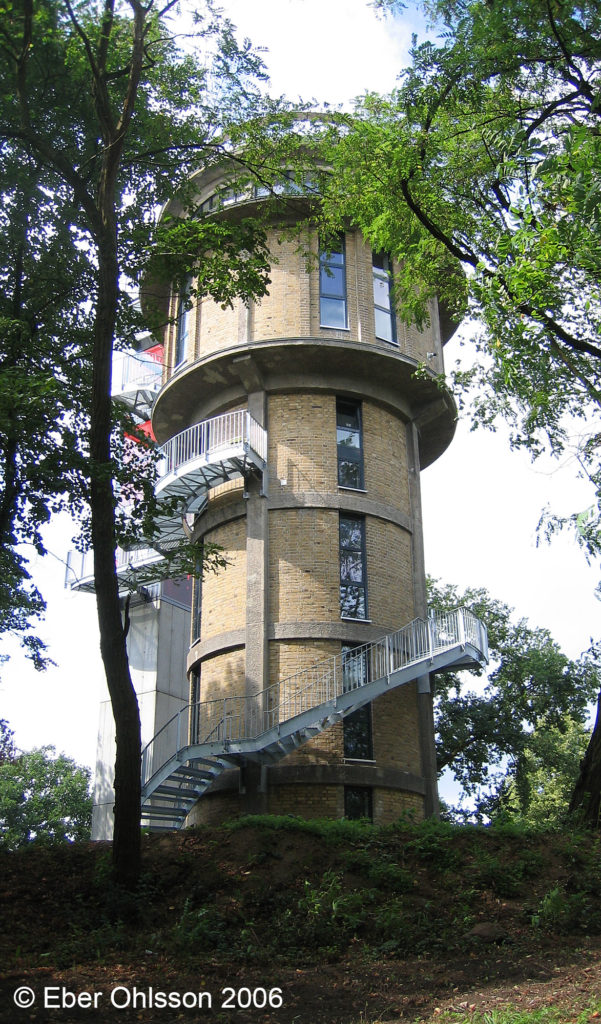
A free translation to English:
One advantage with water towers is the height. Exclusive of pressure in the pipes you also often get a 360 degrees view of the surrounding. Somewhat that is developed on the water tower in Joachimsthal, a small town 50 kilometres north of Berlin.
The tower was built 1960 and was out of operation 1990. It was discovered by the British artist and architect couple Sarah Phillips and Richard Hurding, who now have a 99-year leasehold of the monument protected building. With contribution from EU there has built an elevator tower beside the staircase surrounded tower, now a residence. Therefore can visitors today without charges have a look at the surrounded UNESCO designated biosphere national park.
Published 2006-11-08
Eber’s water towers in Cirkulation 4/2006

The Swedish national football team was stationed in Bremen under the World Championship 2006, the same month as this article was published.
A free translation to English:
The river Weser flow through the old free German Hanseatic town Bremen, with the football arena Weserstadion on the right bank and the city’s oldest water tower on the left bank. The 47 meter high tower in red bricks and cornices of sandstone, four octagonal corner-towers, two cisterns on total 1 700 cubic metres and below pumps operated by steam engines, stood clear 1873 and are drawn by Fr. R. Th. Berg and J. G. Poppe.
In one corner-tower was there a chimney, in two towers inlet and outlet pipes and in the fourth tower a staircase. The tower was hit by a bomb under the last war, but is today restored, declared as a monument and in duty.
Published 2006-06-07
Eber’s water towers in Cirkulation 2/2006
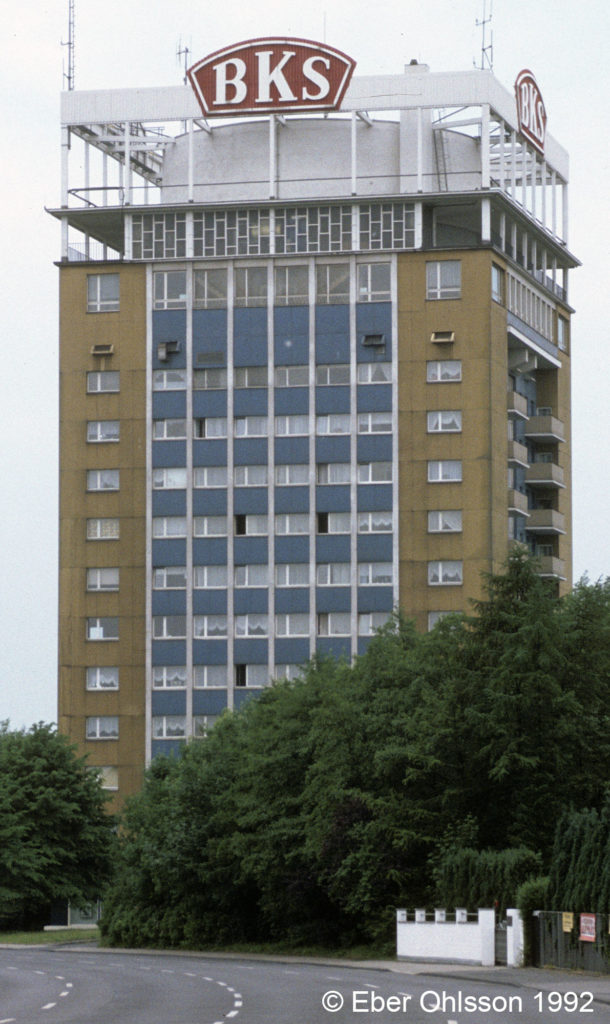
A free translation to English:
Water damages in dwelling-houses are a growing problem according to the insurance statistics. Seeing that it around the world is a lot of buildings that combine dwellings with a water reservoir would these houses according to the logic run a bigger risk to get damages. These risks would not at least touch Germany with its many dwelling-houses with water reservoirs on the top.
In Velbert, a German town between the rivers Ruhr and Wupper was it built a water tower of this type in the year 1957. On the top of the house is there a 10 m high reservoir in pre-stressed reinforced concrete with a volume on total 3 000 m³ water. It is many drops of water that strive down.
Published 2006-03-15
Eber’s water towers in Cirkulation 1/2005

A free translation to English:
Master Engineer G Oesten in Berlin, Germany got in May 1901 by the city of Flensburg in Schleswig a commission to construct a water tower at the existing water works in Mühlenstrasse. This because the supply in the upper pressure zone in the fjord city need to be better. 170 000 Gold mark was allowed to the building.
The building work started in autumn 1901 and was finished in August 1902. The pattern brick-built water tower become 29 m high and got a reservoir on 350 m³. At the final account in August 1902 made it plain that the building work was below the budget with circa 30 000 Gold mark, an experience grant few customer.
Published 2005-02-09
Eber’s water towers in Cirkulation 7/2004

A free translation to English:
Can you call the water tower in Worms in Rheinland-Phalz as a water-cathedral? There are probably reasons for that. The water tower is apparently built in the same style as the cathedral in this German city. While the cathedral has it’s origin in 1000s, was the water tower built in 1888-1890. That characterize the cathedral is the late Romanesque style of 1100s, the same style that architect K Hofmann has applied to the water tower.
The 58 meter high tower has a reservoir on 1 200 m³. It is an expensive building to a city that at this time only had a population of 32 000 inhabitants and a consumption per capita of 103 litre/person and day.
Published 2004-11-03
Eber’s water towers in Cirkulation 1/2004
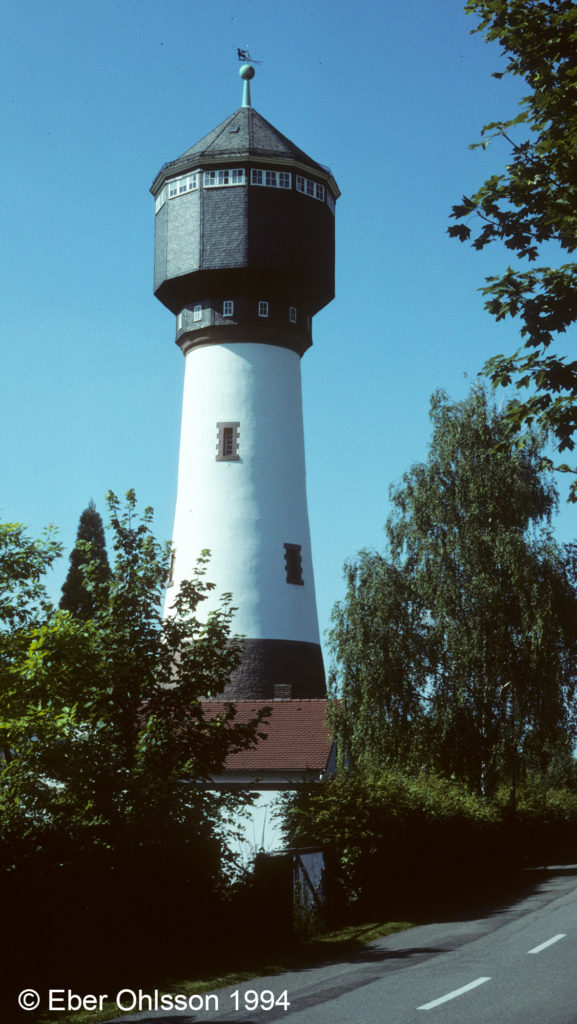
A free translation to English:
The Badische town Kehl in Germany, neighbour to Strassburg, concluded at the time an agreement with Master of Engineering M. Hessemer from Frankfurt am Main, that he for own money should arrange the water supply of the town. On account of the private company’s high water price, the town makes success after an action to take over the operation 1910.
The 1904-1905 private built tower with a total height of 47,5 meter and a reservoir on 300 m³, got a harmonic formation with tower-head that was both rich of idea and complicate. Unfortunately got the origin form lost under the war, but the compensation may be acceptable.
Published 2004-02-11
Eber’s water towers in Cirkulation 4/2003
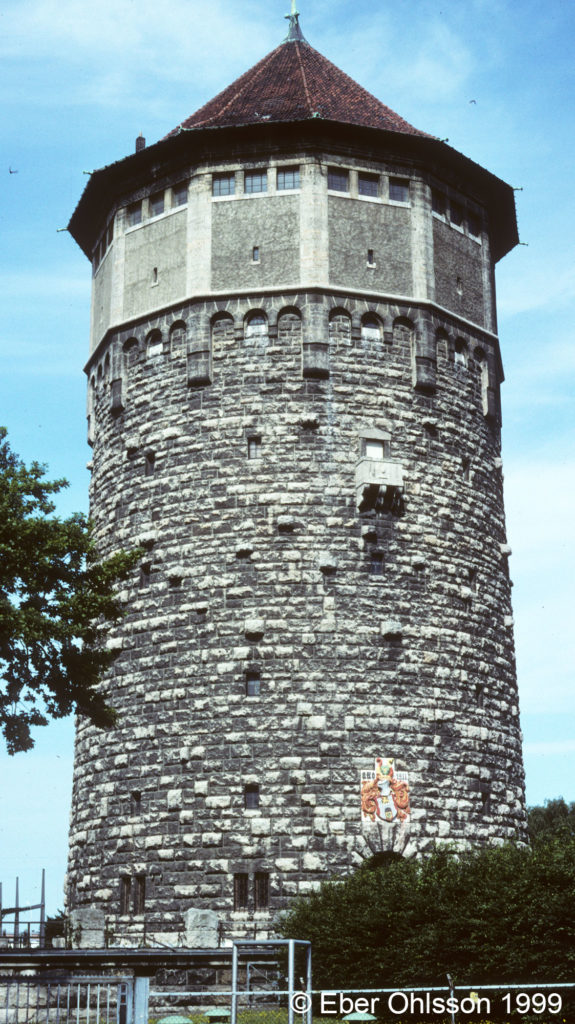
Wasserturm = water tower.
A free translation to English:
The new water tower in the north district Vahrenwald in Hanover had the largest water tower reservoir of Europe when it was new 1911. The riveted Intze-construction holds 4 100 m³ water, and was reposed on 140 steel pillars. The total height above the ground of the tower was 62 meter. The design of the tower in Lower Saxony was by the hand of architect Schaedtler. The façade was rough-hewn blue-green lime-sandstone, with a coat of arms, tall as a man, above the door.
The tower was as many other German towers both bomb damaged and restored. It was at last out of operation 1963, but is now honoured with an own tramway stop – ”Wasserturm”.
Published 2003-06-04
Eber’s water towers in Cirkulation 1/2003
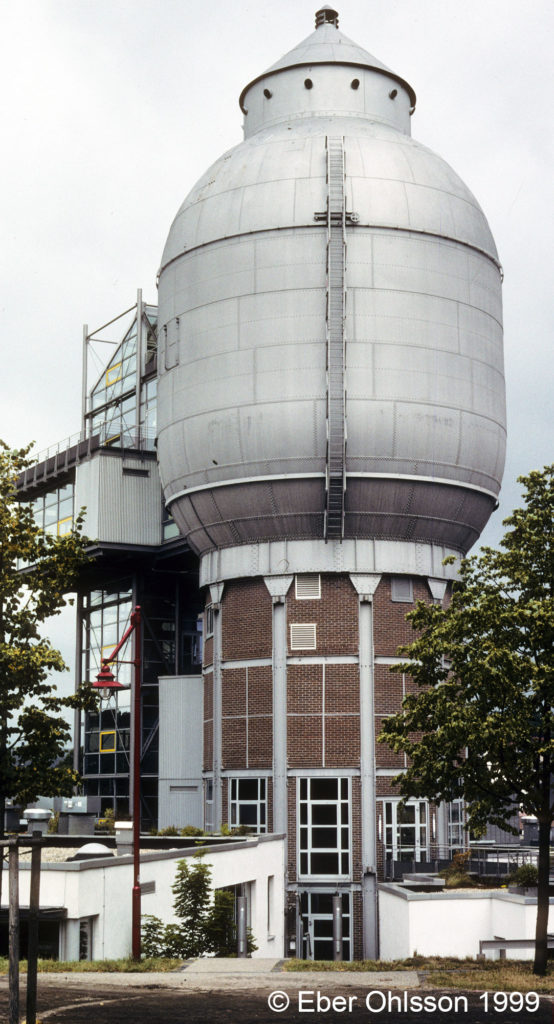
The Swedish word ”biofilm” has various meaning, both ”bio film” and ”cinema film”, biograf=cinema. The German word ”Turm”=tower.
A free translation to English:
Bio film in a water reservoir is regarded as something negative – pollution. In Neunkirchen in the German Saarland is movie [biofilm] something positive, because there are arranged four cinemas in the closed down cooling water tower of the ironworks. The 41 meter high tower with a largest diameter of 14 meter, hold 2 200 m³ water when it stood ready 1936.
The water tower become a historic building 1985, and after rebuilt and extension built 1996 is here now recreation centre, pub, bistro, café and a small brewery with the beer Turm Gold and Turm Black. But even the multi cinema Cinetower, there it perhaps sometimes will be fluid production in form of tears.
Published 2003-02-12
Eber’s water towers in Cirkulation 5/2002
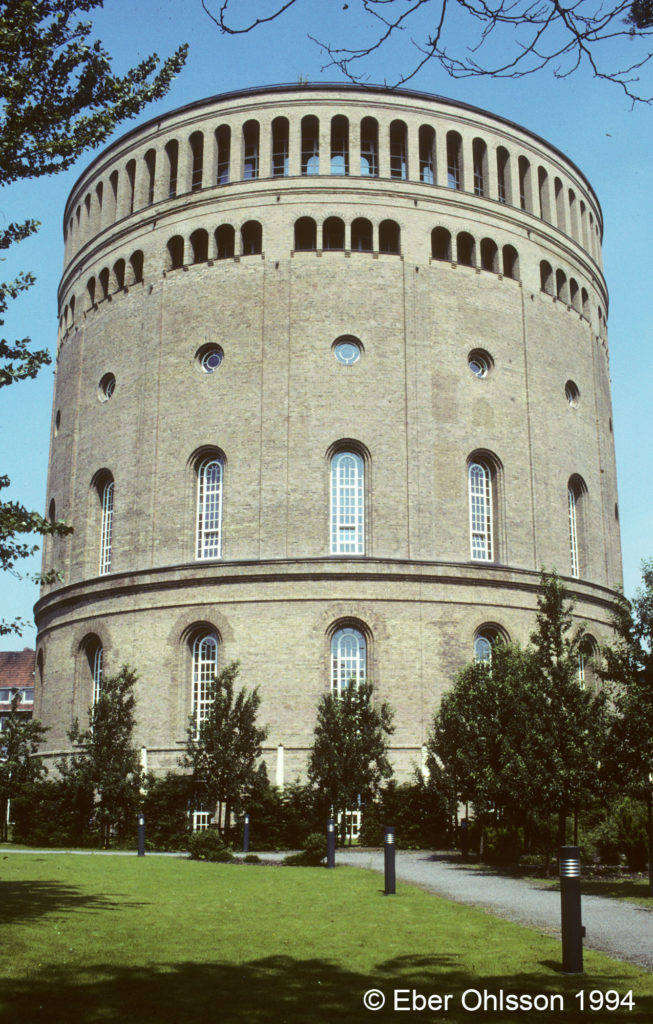
A free translation to English:
Eau de Cologne are perhaps that, as nowadays will fill the old water tower at Kaygasse i Cologne [Köln]. Otherwise was it, when the 35 meter high water tower was finished 1872, at that time it was filled with another form of water from Cologne, 3 600 m³ drinking-water. The English architect John Moore drawn the tower that was out of operation at the earlier turn of the century, after which it house workshops and warehouses.
Under the Second World War was the tower a bunker with thick concrete. The act of war heavily damaged the tower, but it began a new life when it in the end of the 1980s was rebuilt to a exceedingly stylish luxury hotel, perhaps the German’s best and most distinctive, there the guests certainly is surrounded by some ethereal liquid.
Published 2002-08-21
Eber’s water towers in Cirkulation 2/2002

The English word ”leaved” (the last word in the text) is comparing with a Swedish word in the original text that is built on the word (translated) ”drip”.
A free translation to English:
Hydrotherapy (cold water treatment) cures nervous illness. Can it has been thoughts of this therapeutic treatment, that done that when they in the capital of the German Empire Berlin in the end of the 1800s should built a new psychiatric hospital to 1 000 patients, even was planning a water tower? Or was only an establishment that fresh water gives fresh lives. The year 1880 was the hospital in any case finished, with water tower in a central place of the area.
Architect for what today is been called Karl-Bonhoffer-Nervenklinik was Stadtbaurat Herman Blankenstein. The 28 meter high water tower, with a square ground plan, had originally a reservoir on 85 m³, but was enlarged to 90 m³ at a rebuilding 1967, when the copper plate of the reservoir was changed to galvanized steel. To want extent the treatment has changed is unknown, perhaps is some method leaved.
Published 2002-03-20
Eber’s water towers in Cirkulation 7/2001
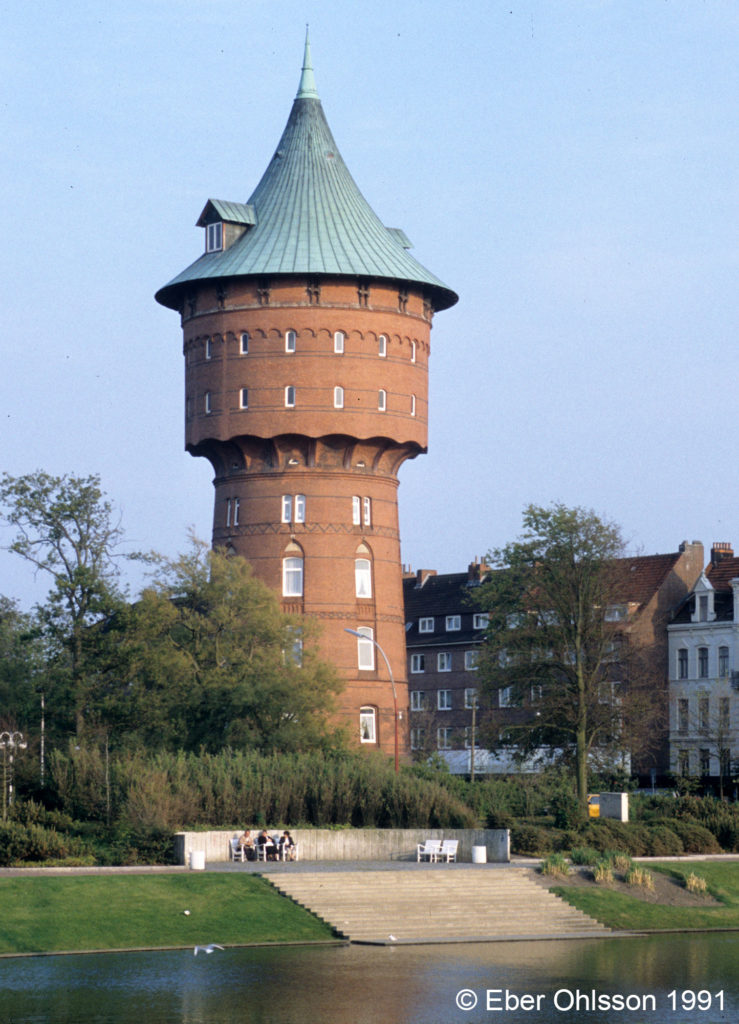
A free translation to English:
Cuxhaven is the last hope to reach its own boat, for the sailor that is left astern in Hamburg (90 kilometres in taxi, which certainly some old engine-men at water works know). The town is of course home port to the pilots of the Elbe River outflow. Should the sailor miss the boat, and still want to have his hammock under the water line, can he perhaps set his hope to the water tower in the town.
Here are four apartments under the 950 m³ large reservoir. The 48 meter high water tower was built 1897, and is a work by the firm Hoffmann in Berlin. On the top are there a spire with a gilt ball, and a vane formed as a dolphin.
When the roof was renovated 1967 found they that the workers had completed the official documents, that was placed in the ball, with own papers. The papers are today valuable social documents. The tower is still in operation, but now as a historic building.
Published 2001-11-07
Eber’s water towers in Cirkulation 4/2001
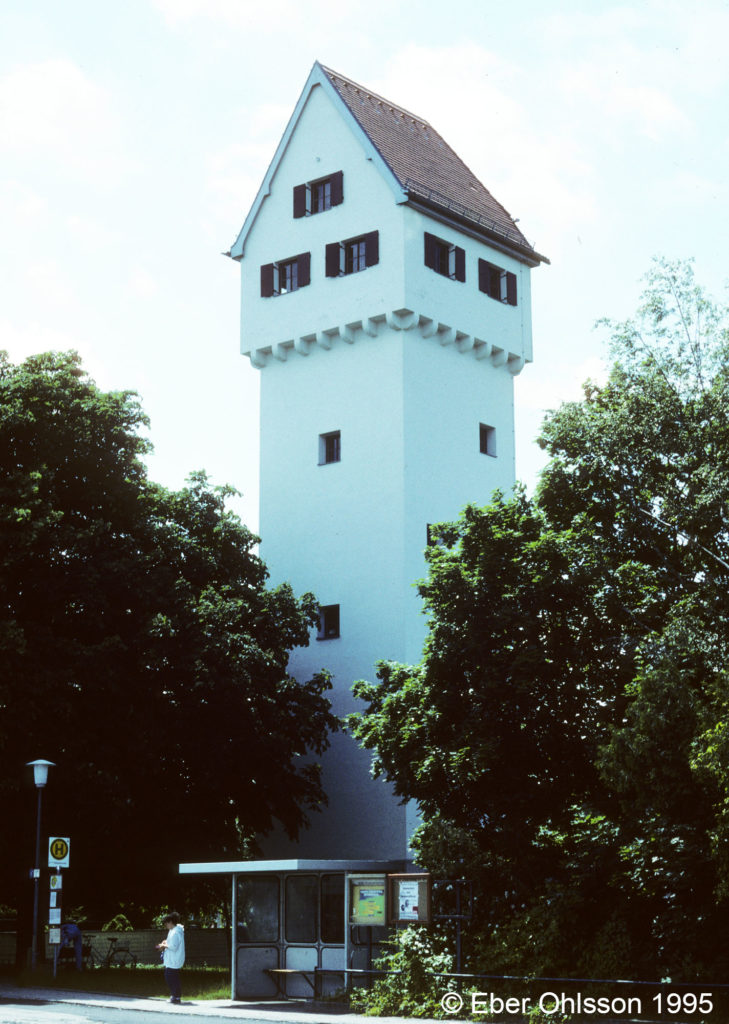
A free translation to English:
A high situated house with a perfect view and there the trees not shadow. That is the impression you get when you observe the 26 meter high water tower in the Garching b. München [Munich] in Germany, a town north of the Bavarian metropolis agglomeration.
The water tower, with a quadratic base on 5,4 meter, was built in reinforced concrete and equipped with a reservoir on 63 m³. The architect is unknown, but the tower was designed in 1909 and was finished in December 1911, with everything under control by the Königlich Bayerishes Wasserversorgungsbüro [Royal Bavarian Office of Water Supply].
The water tower was out of operation 1961, as the wells in Garching had been polluted. Instead get the customers now there’s water direct from the Munich main water system. The tower is since 1981 protected as an industrial heritage, and was restored 1988 in connection with that the reservoir was scraped.
Discussions continue now on what manner the tower shall be used. If it will be an apartment, must doubtless the guests be prevent to walk out on the terrace.
Published 2001-06-13
Eber’s water towers in Cirkulation 3/2001
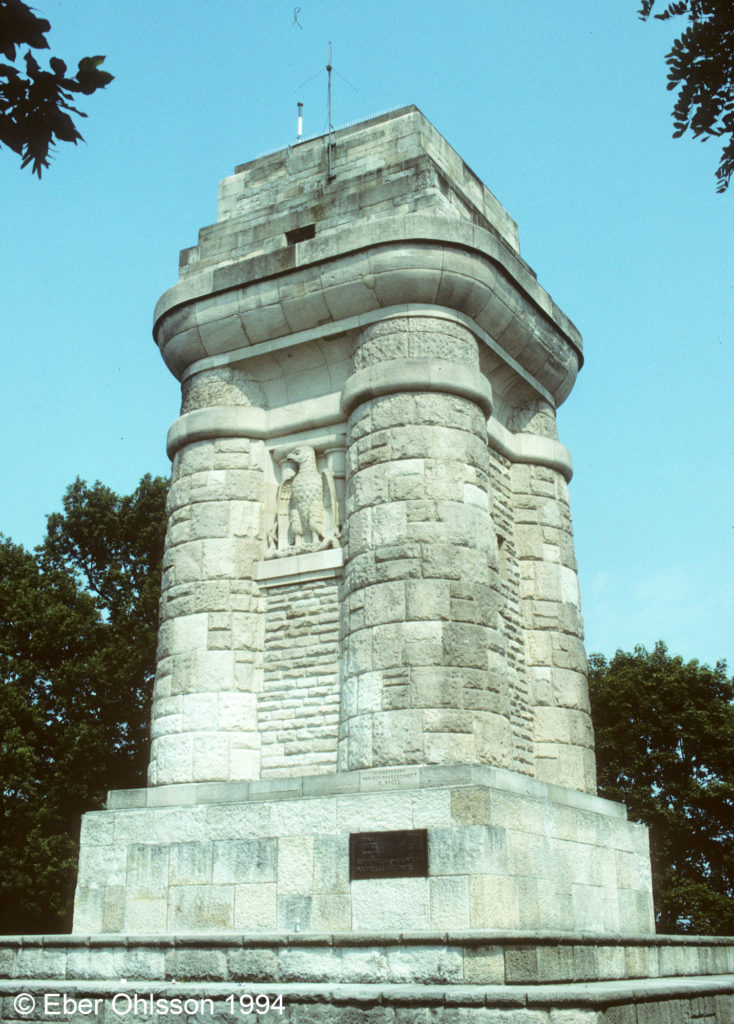
A free translation to English:
Reservoirs on only 25 m³ water, will normal not create a magnificent water tower. But so is not either the Bismarck tower at the heights in the north-western Stuttgart in Germany a usually water tower. It was built 1904 to honour the some year’s earlier deceased founder of the German Reich, Chancellor Otto von Bismarck. Architect for the 20 meter high tower in sandstone was the professor from Dresden, W. Kreis.
Obviously has the altar-like stone pile with its altitude over the capital of Württemberg worked as a belvedere, but on the top has there even burnt midsummer fires.
It was however not the need to put out these fires, but more the need to get a better water pressure for the nearby residential districts, that done that they the year 1928 made a water reservoir in the monument. The limited reservoir volume gave a small surface of water on only 4,5 x 2,5 meter, a surface of water that however get up to the height 426 meter over the sea.
Published 2001-04-27
Eber’s water towers in Cirkulation 2/2001
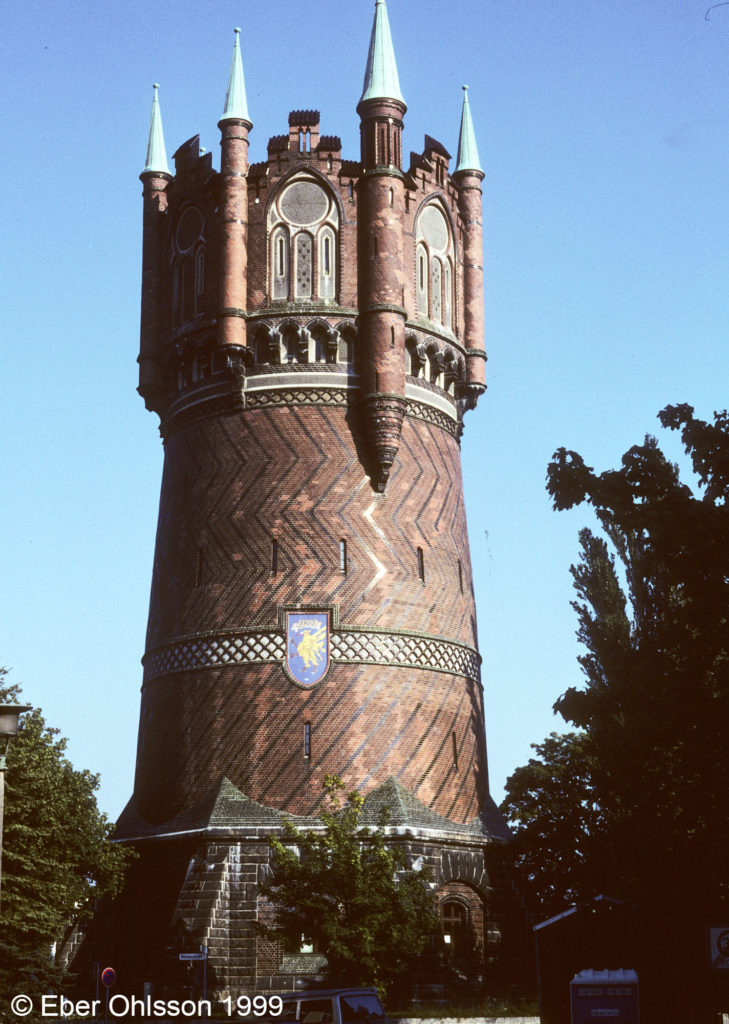
A free translation to English:
The Gothic was the architecture style that set the tone in the north German Medieval towns. What could be more natural to the self-assured towns than to be inspired of this Gothic, when they a century ago should build up the public services? The north German Gothic church with its high spire got their imitator in the new technical era’s new Gothic water towers with pinnacles, as in the hanseatic city Rostock in Mecklenburg, Germany.
Here stand since 1903 a water tower made of bricks in pattern style with seven stepped gables and with blind windows, all rest on a base of granite. It was Stadbaudirektor Dehn that designed the 60 meter high water tower with a diameter of 18 meters in the base.
The tower was holding a reservoir on 800 m³ water until it was out of operation 1959. After a restoration is the tower now a historic building and house a city museum warehouse, and in the ground floor also a meeting-place for children and disables.
Published 2001-03-21
Eber’s water towers in Cirkulation 8/2000
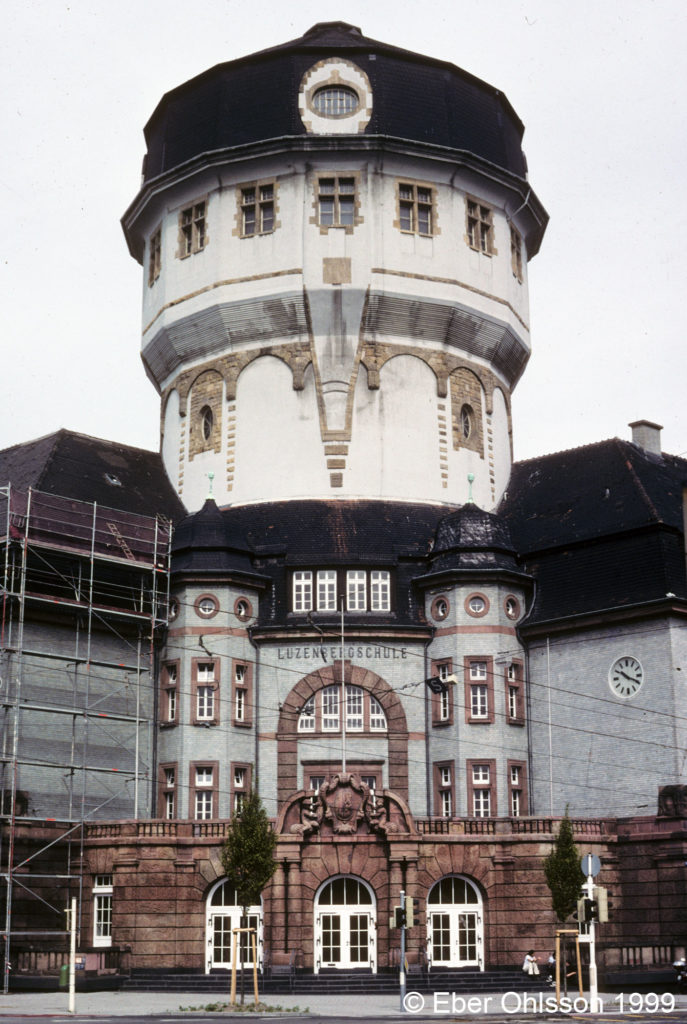
A free translation to English:
School examples of water towers are there in the Badische city Mannheim in Germany. In the district Luzenberg is the water tower and the school an integrated building complex. This quite not usual combination began 1907-08 when the water tower was built as a solitary.
Thereafter was under the year 1912-14 the school built, in main two wings up to the tower. The inner room decoration of the school was not unexpectedly based on the theme water. The water tower is 56 metres high, and had a reservoir on 2 000 m³ before it was out of order 1970.
Now has the tower been a very high circular ”acoustic” junior common room with cafeteria to pupils of the school. Today’s modest tower roof is a new construction, as the bombing under the Second World War damage the old roof, a roof with steep raising, finished with a sphere.
In spite of the reduced height of the tower is the building a marked element in the general aspect of the town and has been the symbol of Luzenberg. Rightly has the Art Nouveau water tower been declared as a historic building.
Published 2000-12-13
Eber’s water towers in Cirkulation 5/2000

A free translation to English:
The earlier times water demanding railway traffic – steam locomotives, demand that this small mobile water reservoirs now and then was filled up with new water. For this purpose were there built stationary water reservoirs, often small standard water towers.
There are examples of more individual forms, as the water tower at Dortmund Südbahnhof [South Railway Station]. The German State railways built 1927 a 43 metre high water tower in reinforced concrete, which was designed by the architects H Lehman and M Venner.
Except two concrete cylinders, with a total reservoir volume on 800 m³ in the upper third part of the building was the tower even filled with office, room to accommodations and baths for the railway staff. The façade, there the floor is marked with horizontal plaster cornices, is oriented to the brick expressionist idiom of the ”Amsterdam school”.
The reservoirs that was supplied from the common main supply, was in operation until the swan song of the steam epoch in the end of the 1950s. The water tower is now a historic building.
Published 2000-08-30
Eber’s water towers in Cirkulation 2/2000
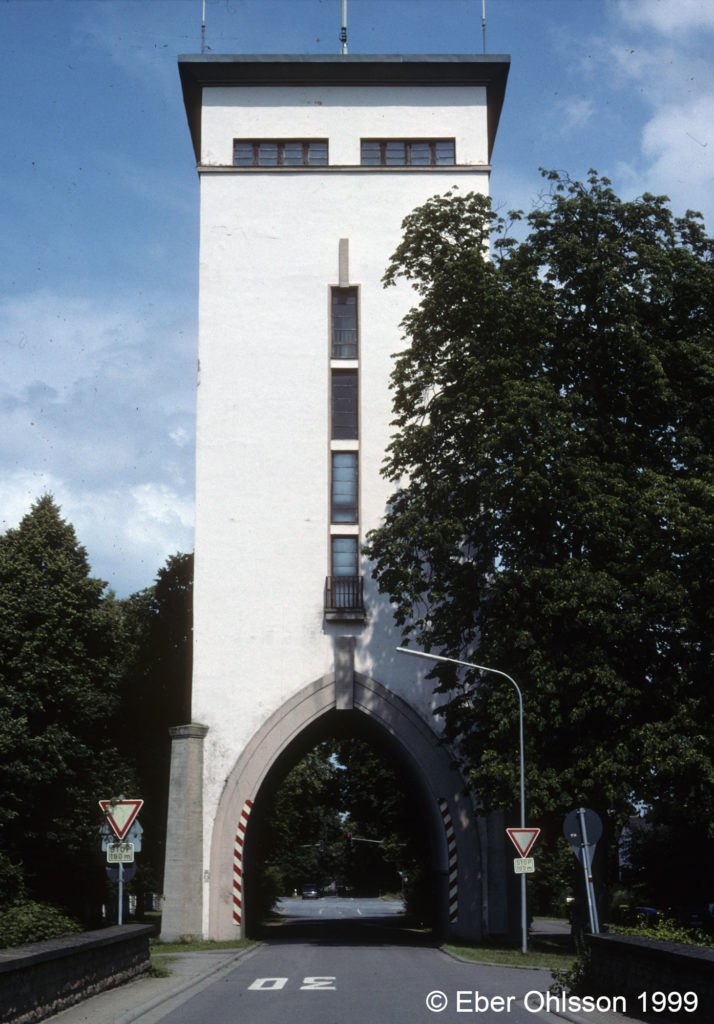
A free translation to English:
In Babenhausen, Germany has it been possible to drive cars under the water. Straight over the Bürgermeister Rühl-Straße [Mayer Rühl Street] in this town in southerly Hesse [Hessen] is a water tower standing since 1928 like a medieval town gate tower. The brick-built tower with a height of 31 metres and with a quadratic base of 10 metres is laid on four pillars of Hesse basalt and it’s been crowned by a copper roof.
The tower with a reservoir volume on 2 000 m³ had a cost at that time of 300 000 German Reichsmark. Constructer was the Mannheim firm Brand and the tower is considering as a typical work of this firm. With a width of 6 metres bridge the Gothic valve over the axle between the medieval city castle of Babenhausen and the hunting seat in Harreshausen.
The tower, that under the Second World War was doing duty as an archive to important documents of the town, is now out of operation and declared as a historic building.
Published 2000-03-22
Eber’s water towers in Cirkulation 8/1999
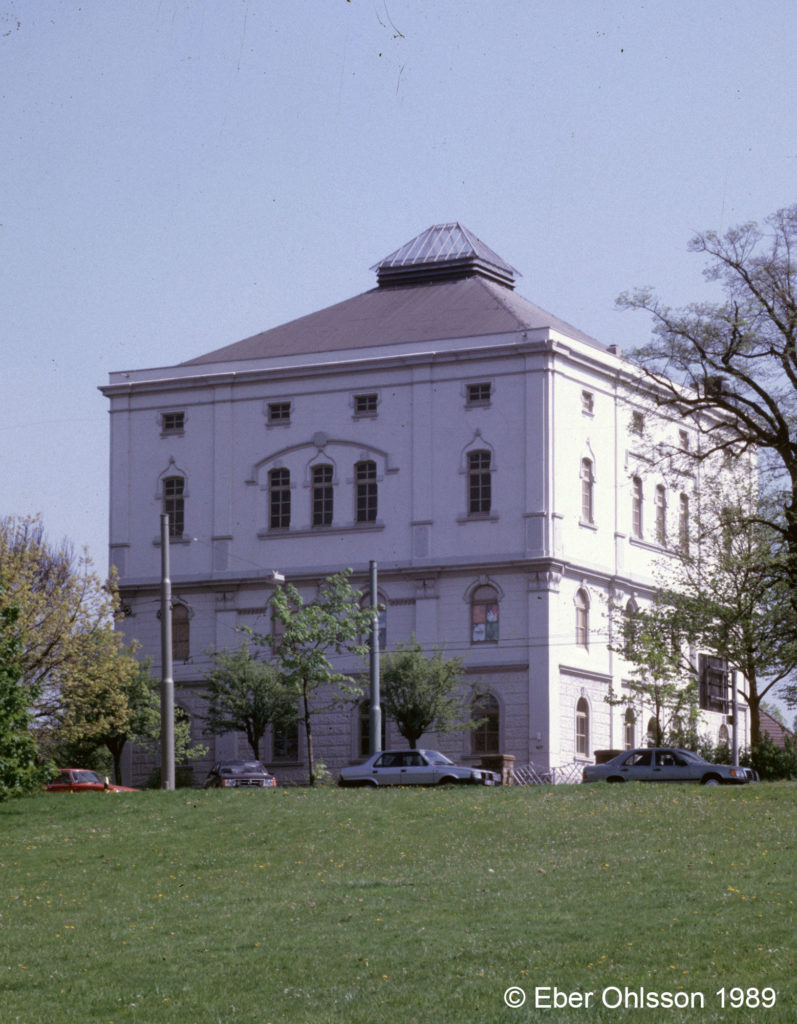
The Swedish word ”synvilla” is ambiguous. It can mean both ”optical illusion” and ”villa=house”.
A free translation to English:
An optical illusion in Bochum is the very elegant dwelling-house on Hattinger strasse in the district Weitmar. The shape of the exterior don’t expose that this building once has been a water tower. The idiom of the villa/tower rather gets the thoughts to more southerly districts than their place in the central Ruhr Area.
When the water tower was completed in 1905 had it a volume on 2 000 m³, divided on two reservoirs. The Federation of Water Works in Bochum [Verbandswasserwerk Bochum] took the water tower out of operation 1959 and sold it 1971 to the City of Bochum for a symbolic sum. Now is there a national puppet museum in the old water tower.
Published 1999-12-08
Eber’s water towers in Cirkulation 6/1999
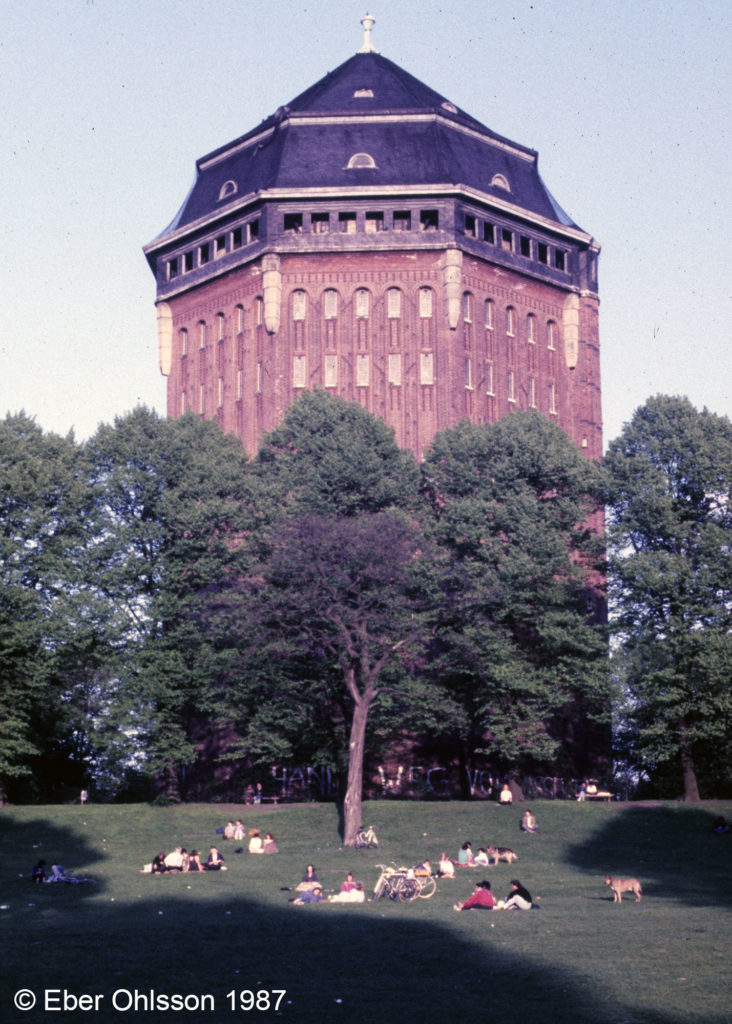

A free translation to English:
”Hände weg vom Wasserturm!” is one and a half meter high graffiti exhortation that it in many years has been possible to read on the water tower in Sternschanze in Hamburg. In a free translation will it be an exhortation to hold the hands off from the water tower, an exhortation that apparently not has been guilty to them who write on the beautiful brick wall. The concise text has periodically a more wordy exposition in the Internet, everything touch bottom in a dispute between they that rule Hamburg and some of the local people. The dispute concern how the tower that’s was out of operation 1961 shall be used in the future.
The history of the tower began otherwise with an architecture competition at the earlier turn of the century with 135 received proposals of tower shape. The proposal that was executed was the octagonal and 60 metres high water tower with a largest diameter of 32 metres. The tower had when it was completed 1907/1908 two reservoirs on each 2 150 m³, low zone respective high zone. The tower is now a historic building, and gets a peaceful future in the old fortlet area.
Published 1999-09-29
Eber’s water towers in Cirkulation 2/1999
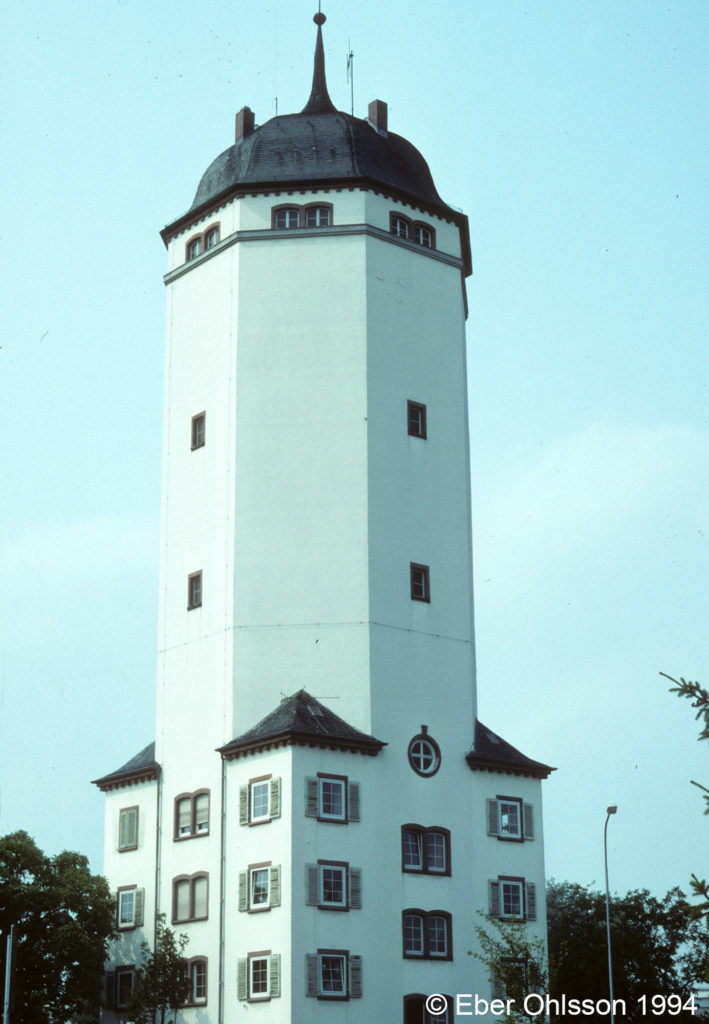
A free translation to English:
Live close to the water are regarding as very attractive, and what was in that case not more attractive than to live in a water tower. Logic is there many water towers that even contain apartments, as an example is the water tower in Seligenstadt in the south Hesse [Hessen] in Germany. A smaller town from 800s with all the qualities that there are in older German towns, and water tower that in the style harmony with the local building tradition. It means that the tower seems to be older than the building year 1936/37.
The 50 metres high building with a reservoir on 500 m³, is not longer in operation, which has done that there are plans to have apartments even in the upper part of the tower building. The tower is now standing as a symbol of the town, equal with the basilica and other very old buildings. The citizen of the Seligenstadt live even with a drained water tower close to the water, because the idyllic town with its old half-timbered houses is situated at the west bank of the river Main.
Published 1999-03-24
Eber’s water towers in Cirkulation 7/1998
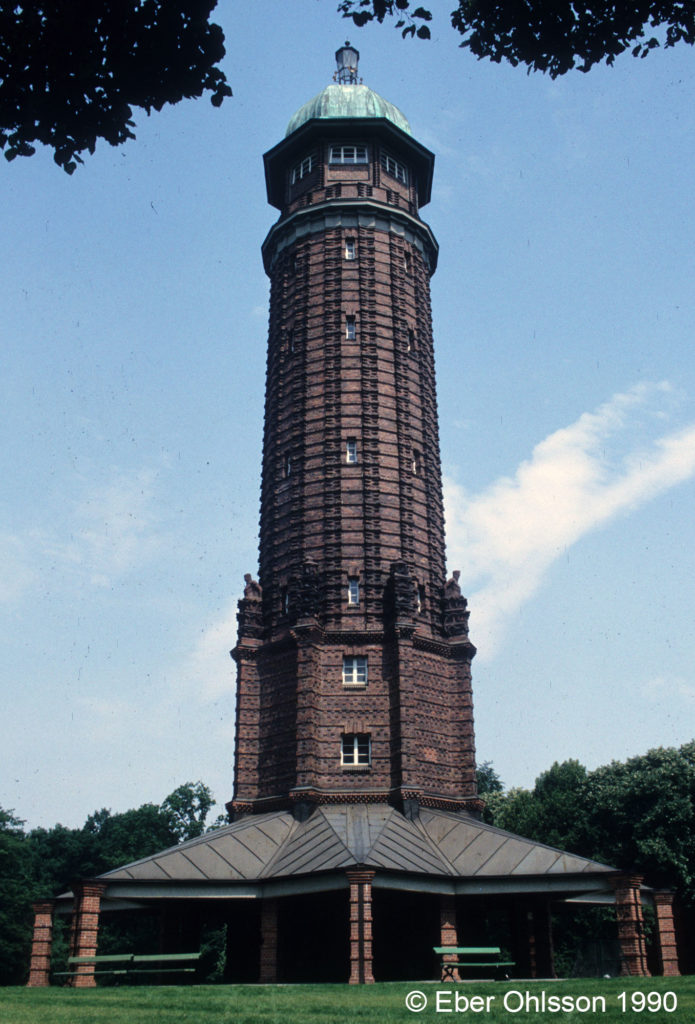
The English word ”mediocre” is translated from the Swedish word ”slätstruken”, which also mean ”plain surface”.
A free translation to English:
Many bricks for little water – that can perhaps be a summary of the water tower in Volkspark Jungfernheide in Berlin. It is not a mediocre water tower; instead create here the bricks a front that is rich in contrast, full of life and exciting. Architect for this building, as far as style is concerned can be categorized as brick expressionism, was Magistratsoberbaurat Walter Helmcke.
The 38 meter high water tower was built 1926/27, and with a high-reservoir on 200 m³ supplied it the park with irrigation water under the short time it was in duty. Under the war was the tower badly injured, but was restored in the 1950s. A loggia was built 1987/88 on the place there it in the original drawings should have been a restaurant.
Published 1998-11-04
Eber’s water towers in Cirkulation 6/1998

A free translation to English:
The city of Flensburg in the north German federal state Schleswig-Holstein is situated in the innermost part of the fjord that carries the name of the city. On the western side of the fjord, Altstadt is there a beautiful traditional pattern brick-built water tower in yellow and red bricks, built 1901-02.
On the heights east of the fjord there is a water tower that forms a shape contrast to the old water tower, both to colour and to form. It is a water tower that uses the possibility of the concrete to build in exciting geometrical forms. Architect professor Fritz Trautwein has here 1961 constructed a water tower; there the parabola segment round a vertical is strong marked on the tower shaft, and additional emphasized the light and thin vertical moulding.
To the facile price of 1 D-Mark, it is under five summer months possible to visit the 26 meter above the ground situated belvedere, surrounded a reservoir on 1 500 m³, and there admire the view over the fjord of Flensburg and the Danish South Jutland.
After a such visit can they that not only want water, with advantage visit the nearby Hotel ”Am Wasserturm”, and get water mixed with yeast, malt and hops.
Published 1998-09-23
Eber’s water towers in Cirkulation 1/1998
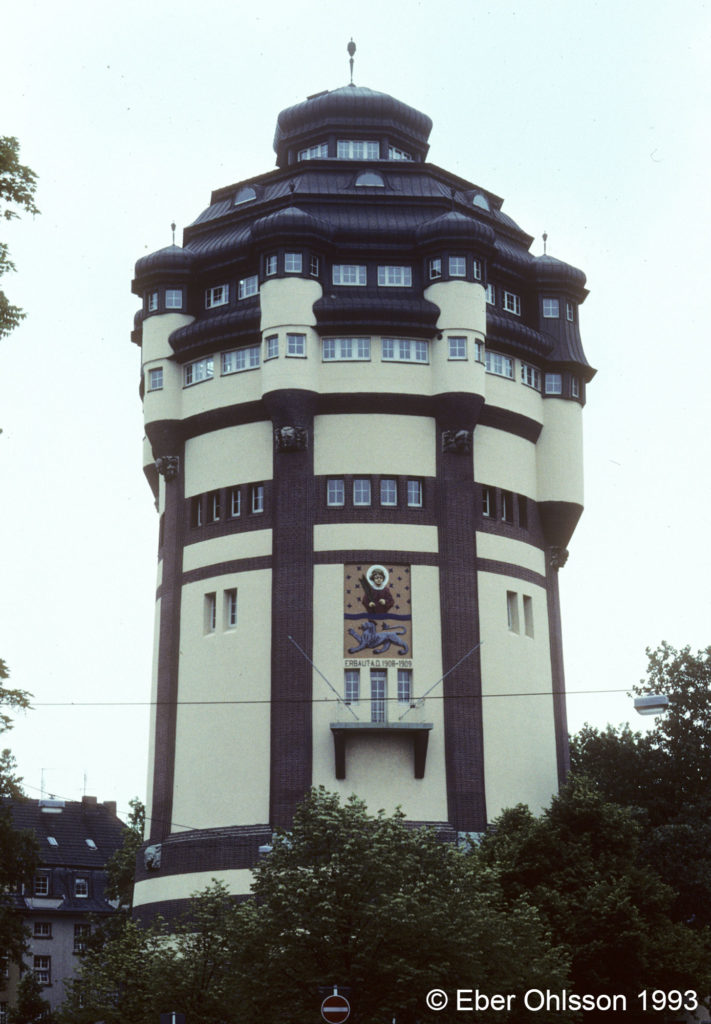
A free translation to English:
A German water tower in Art Nouveau is the pride of Mönchengladbach. Rightly, the question is if there is a more beautiful water tower. But so had it even the cost the city 216 000 Gold mark, when it stood ready 1908-1909.
To this amount they got a reservoir on 3 100 m³. If you today even want to see the water tower inside, it is possible to make use some of the five Saturdays every year, when there is a public showing of the water tower in Viersener Strasse.
Published 1998-02-11
